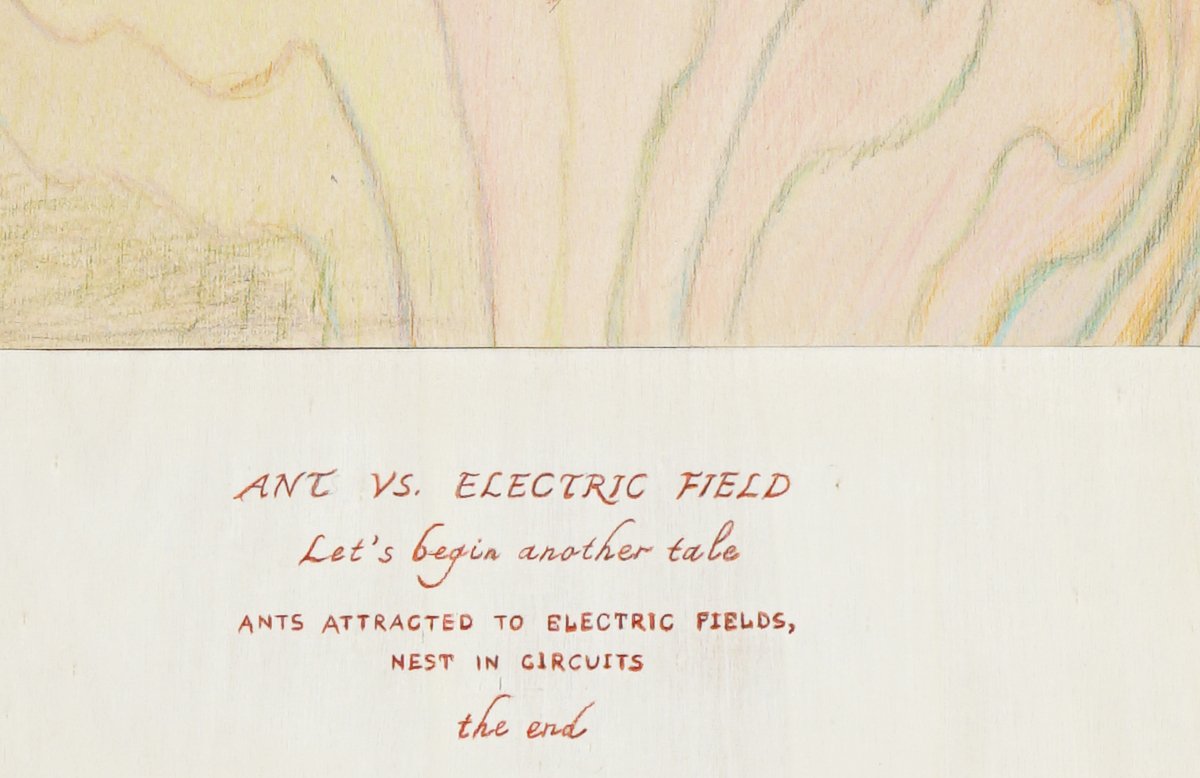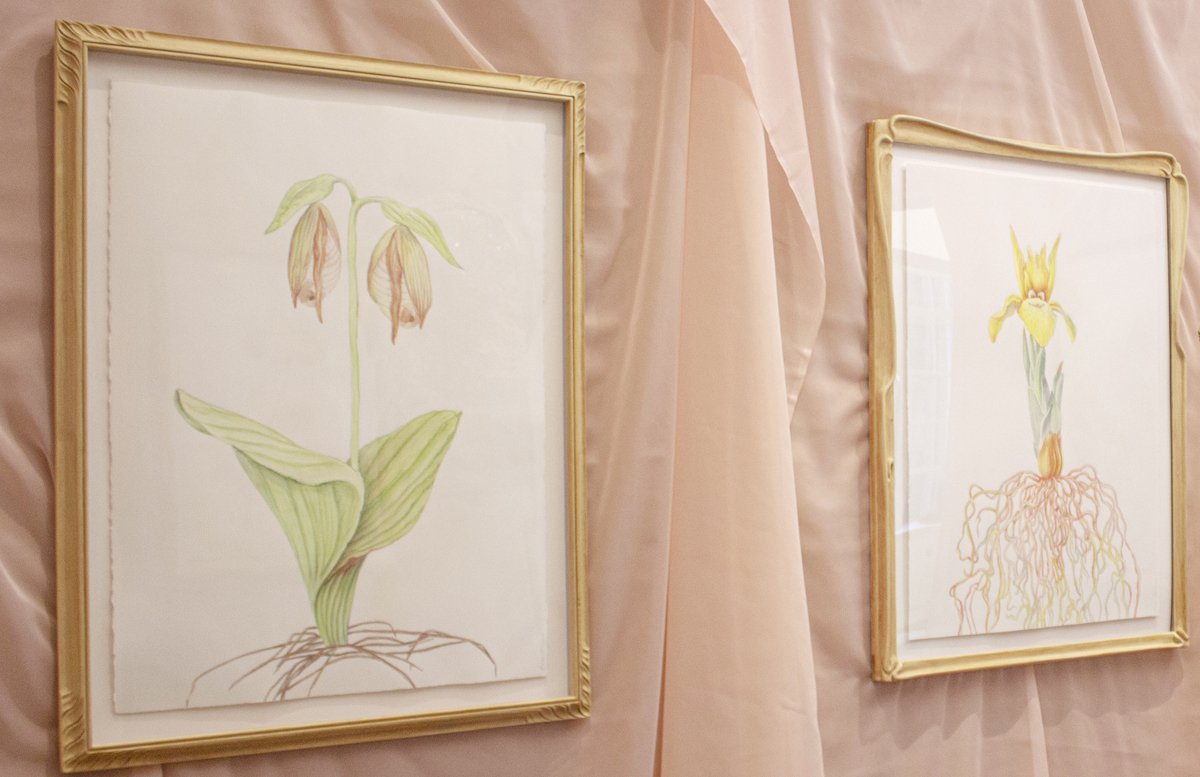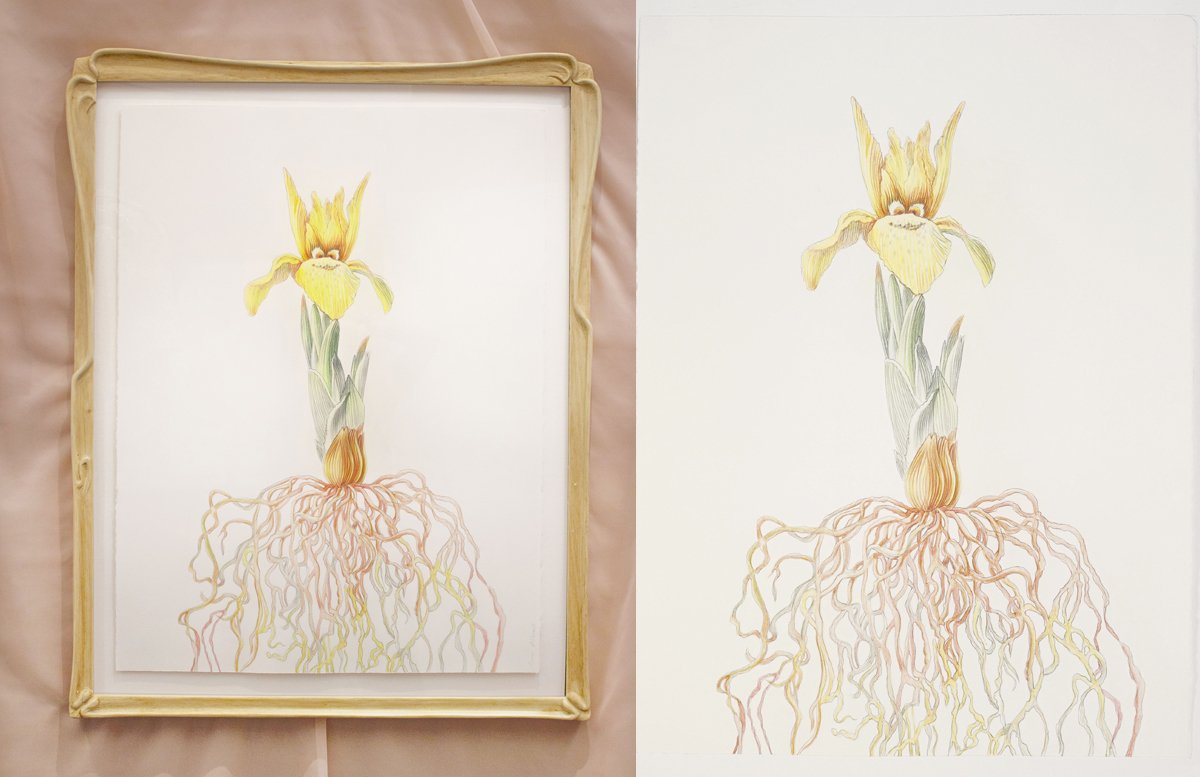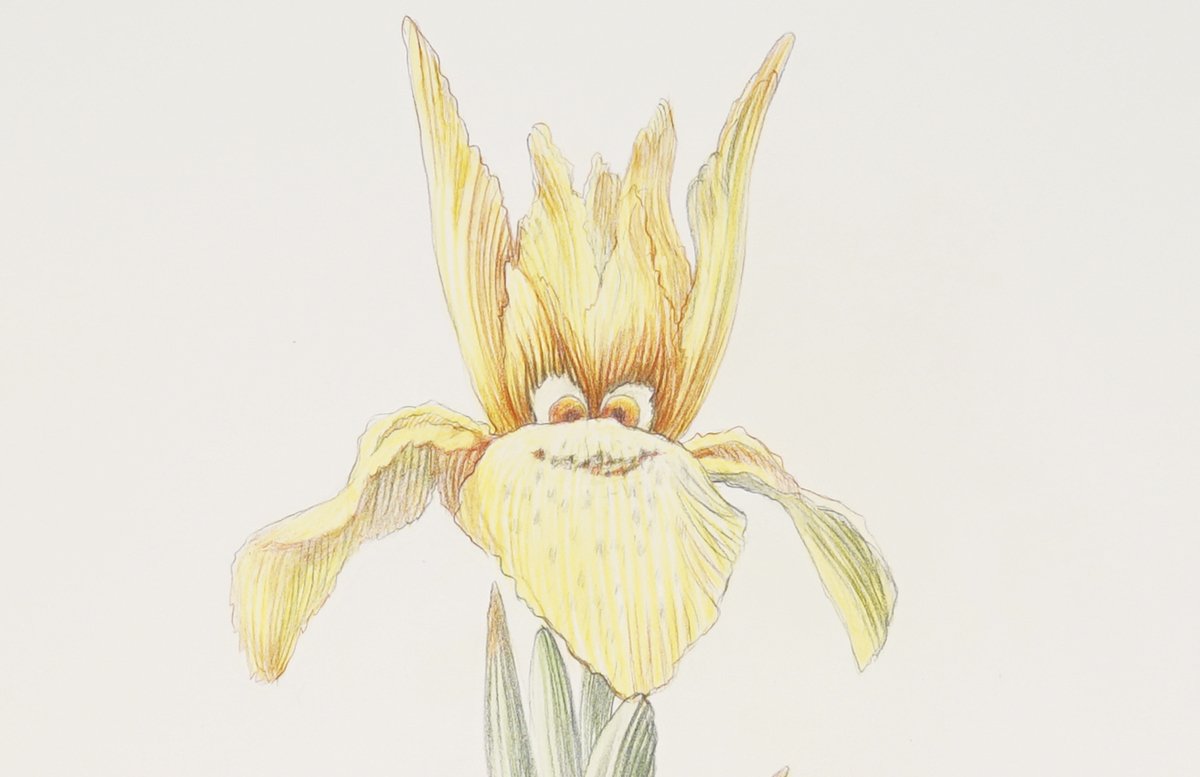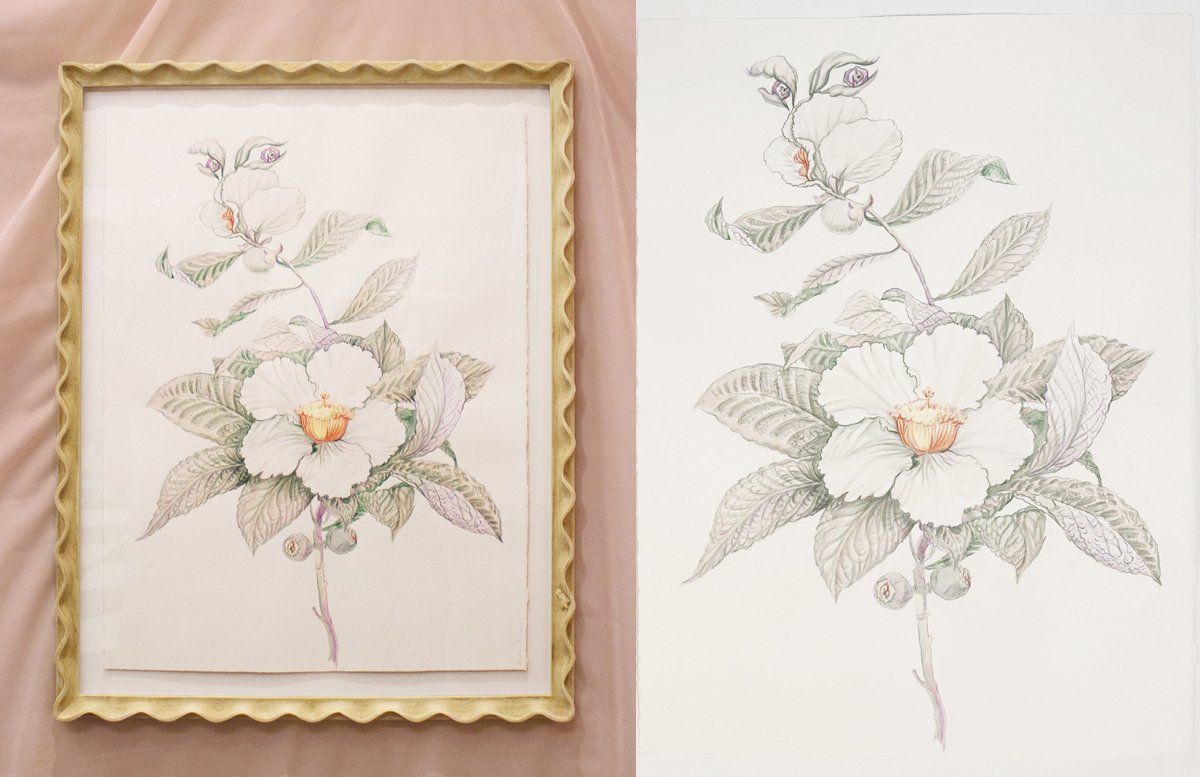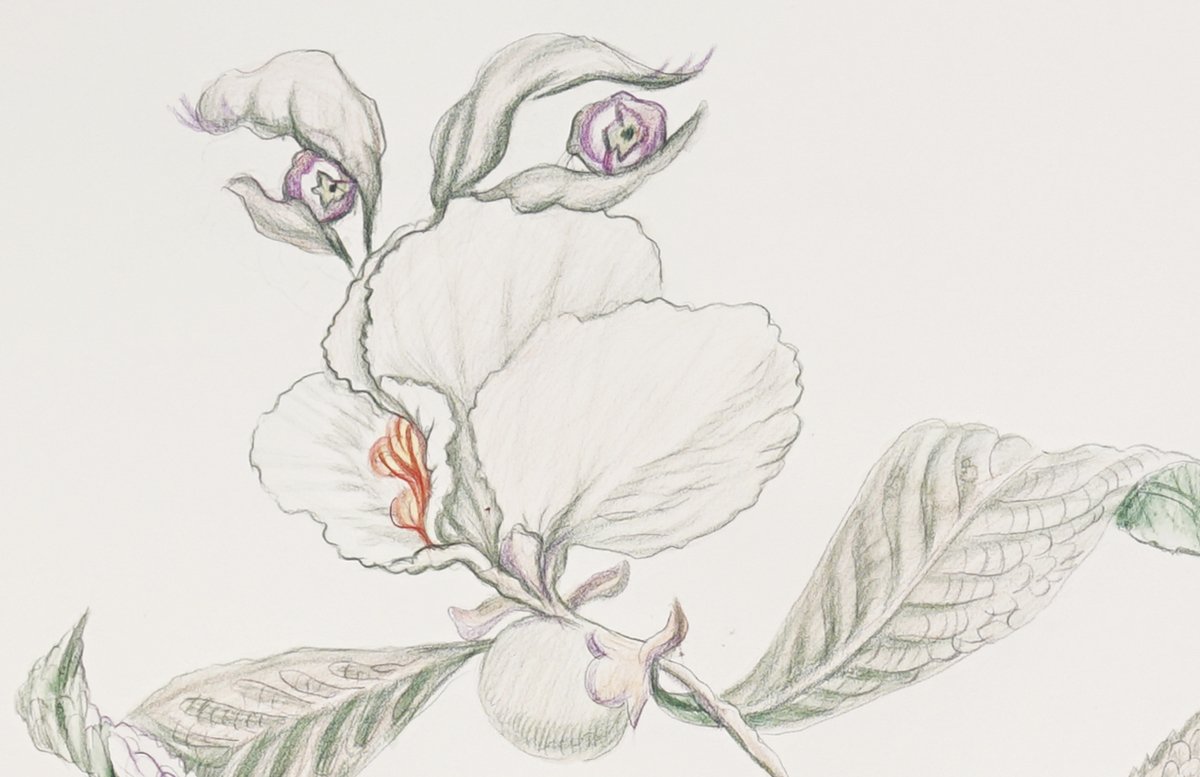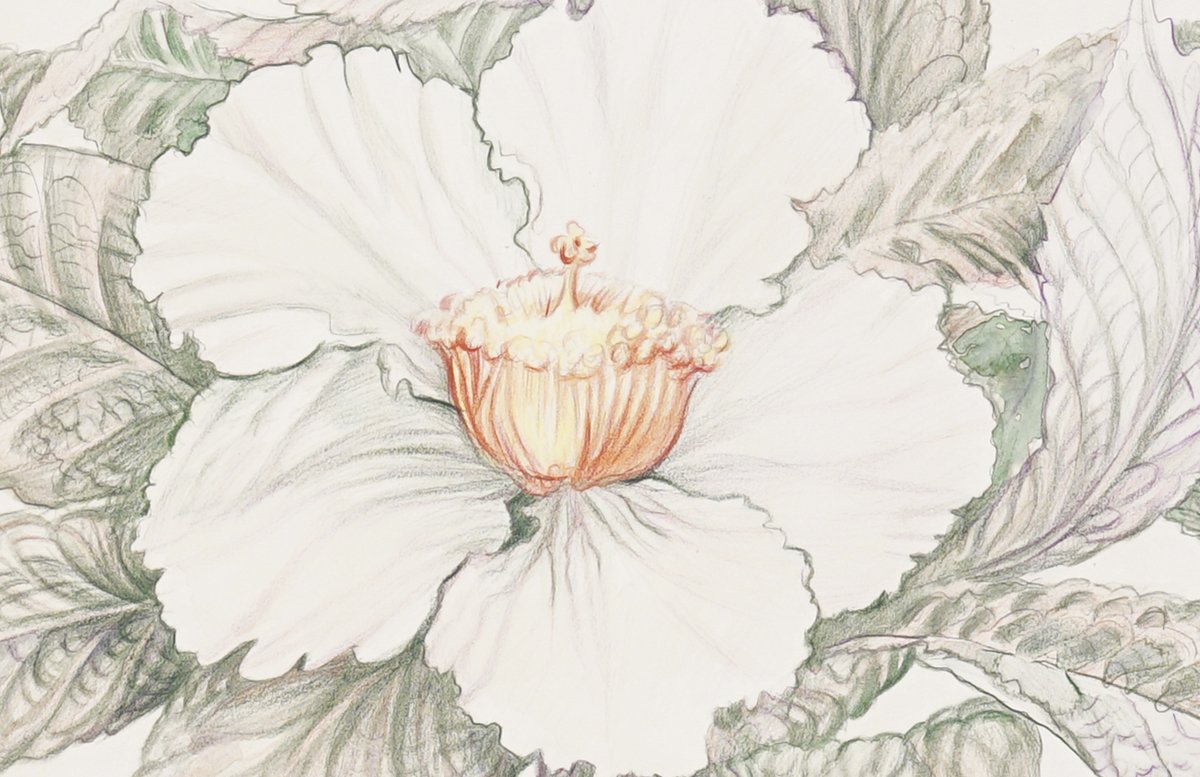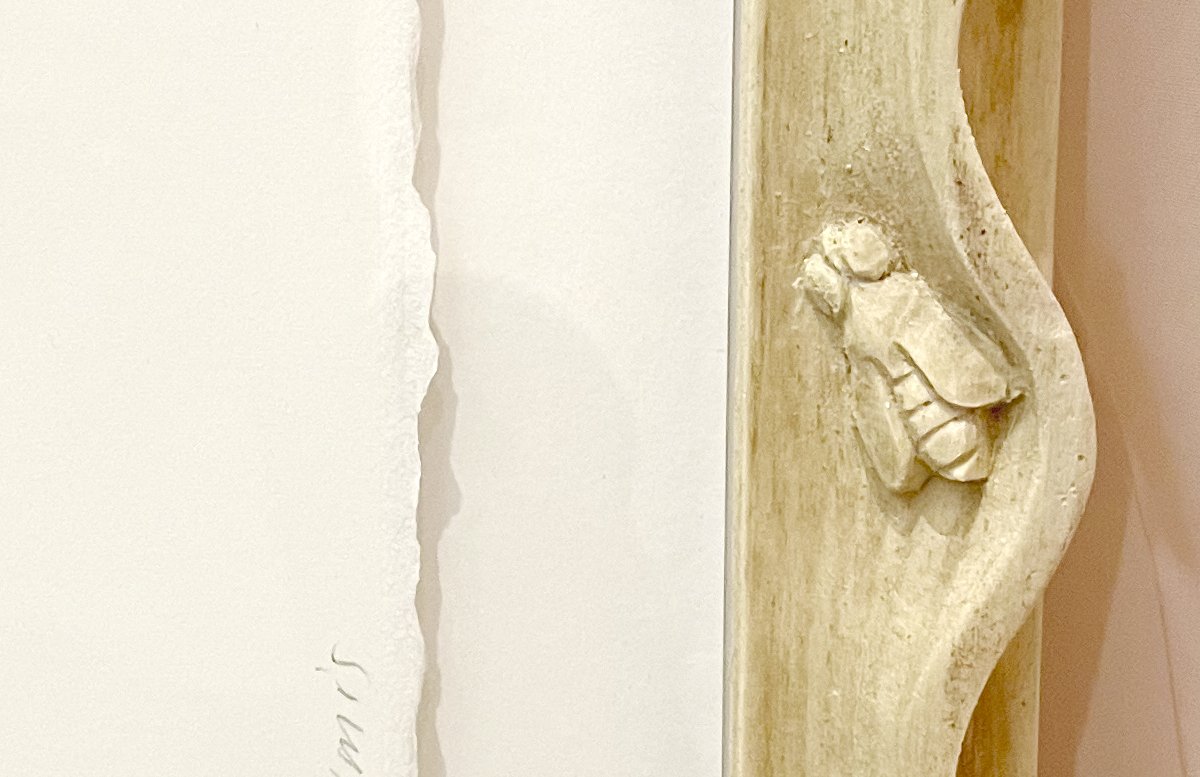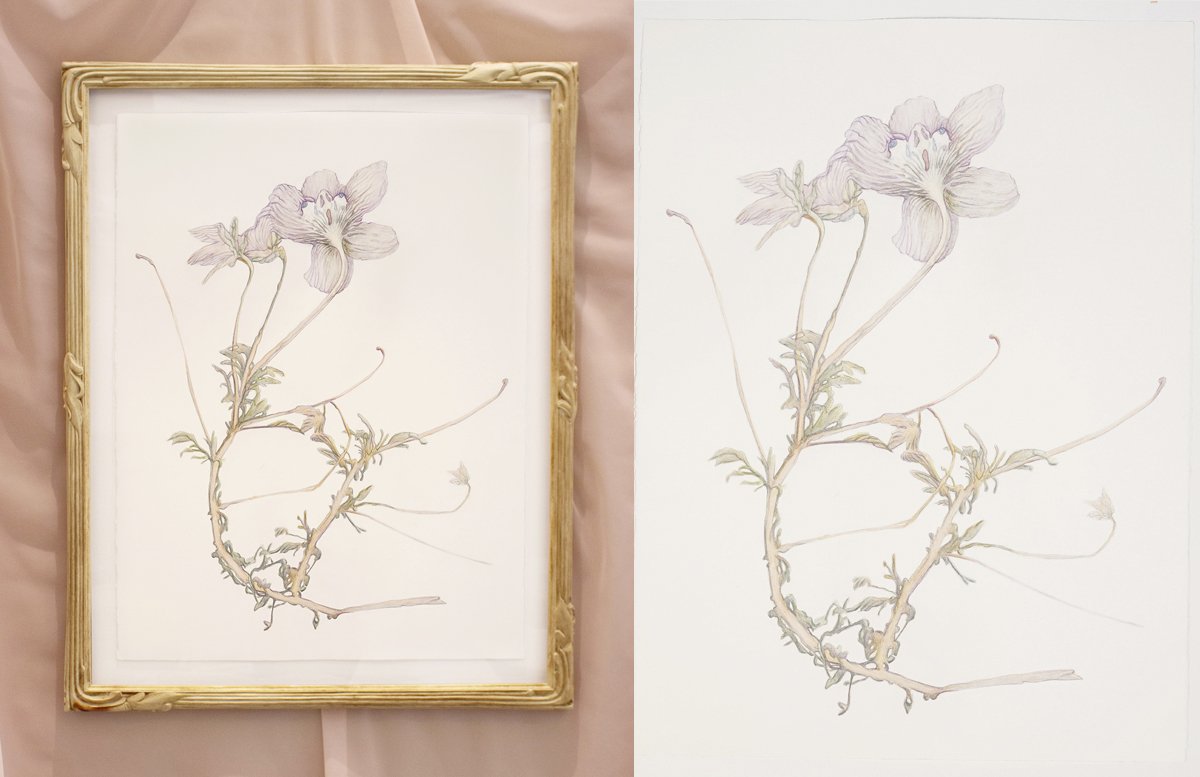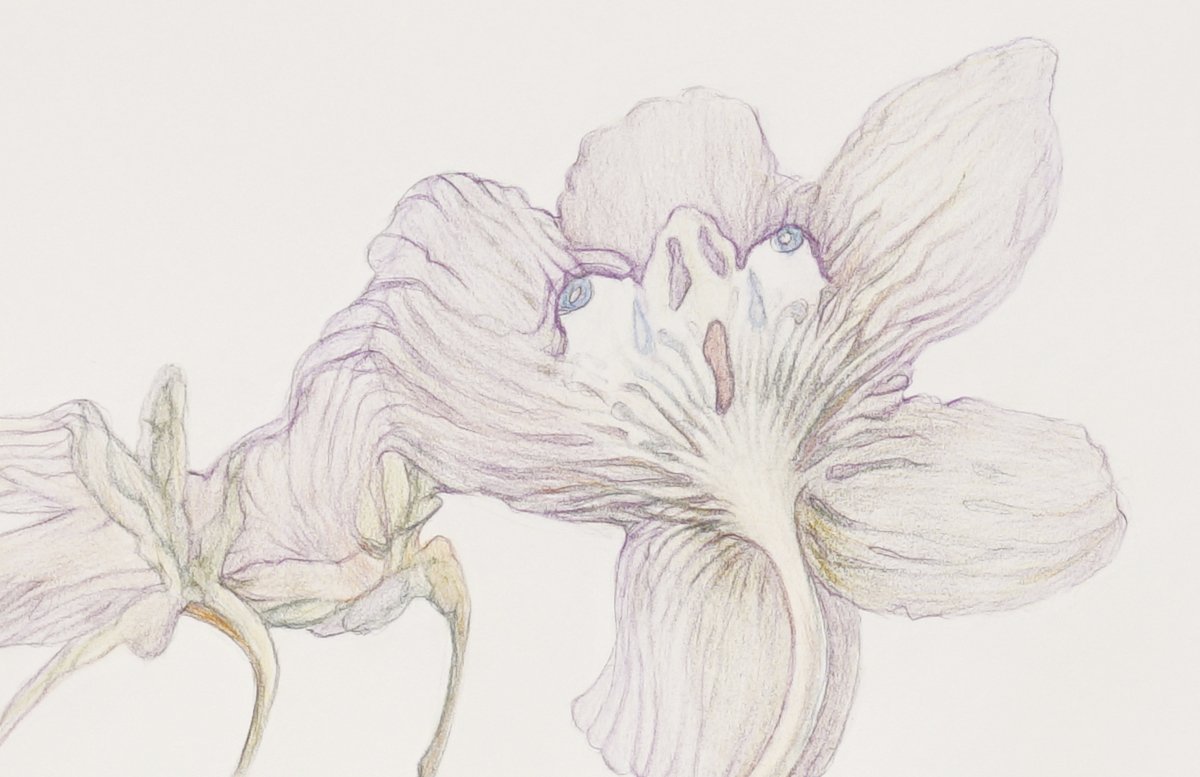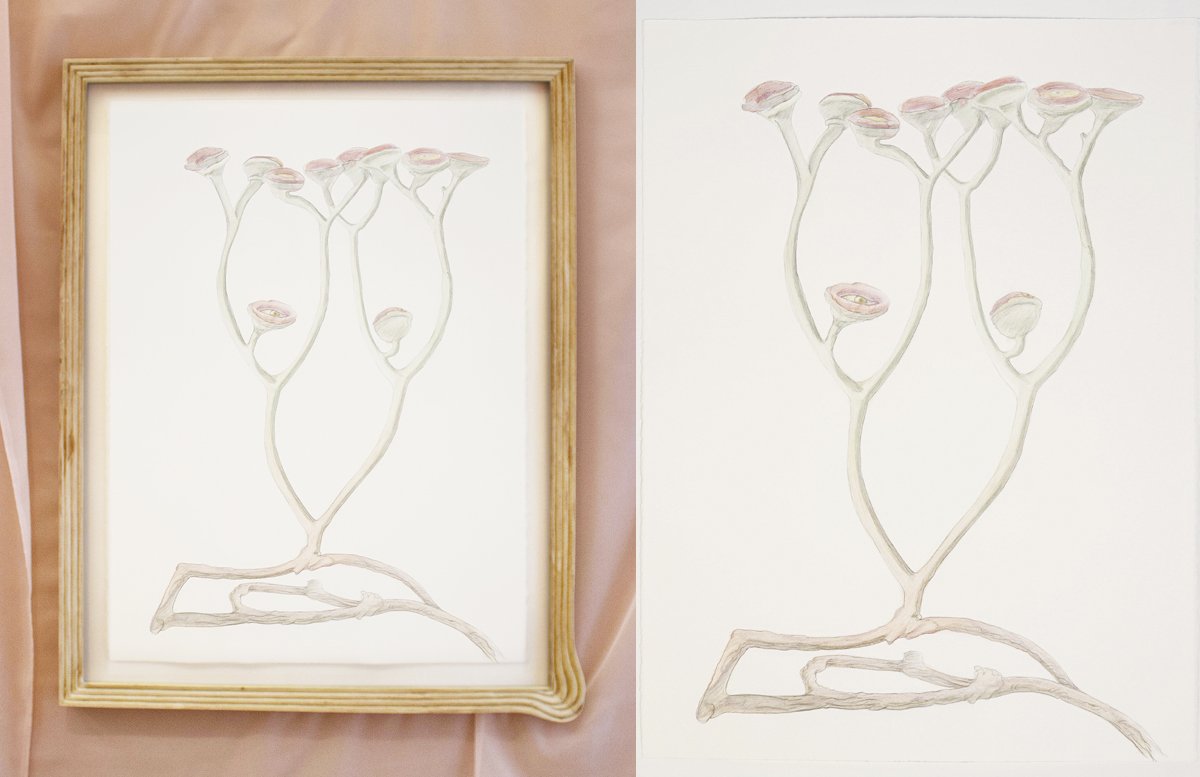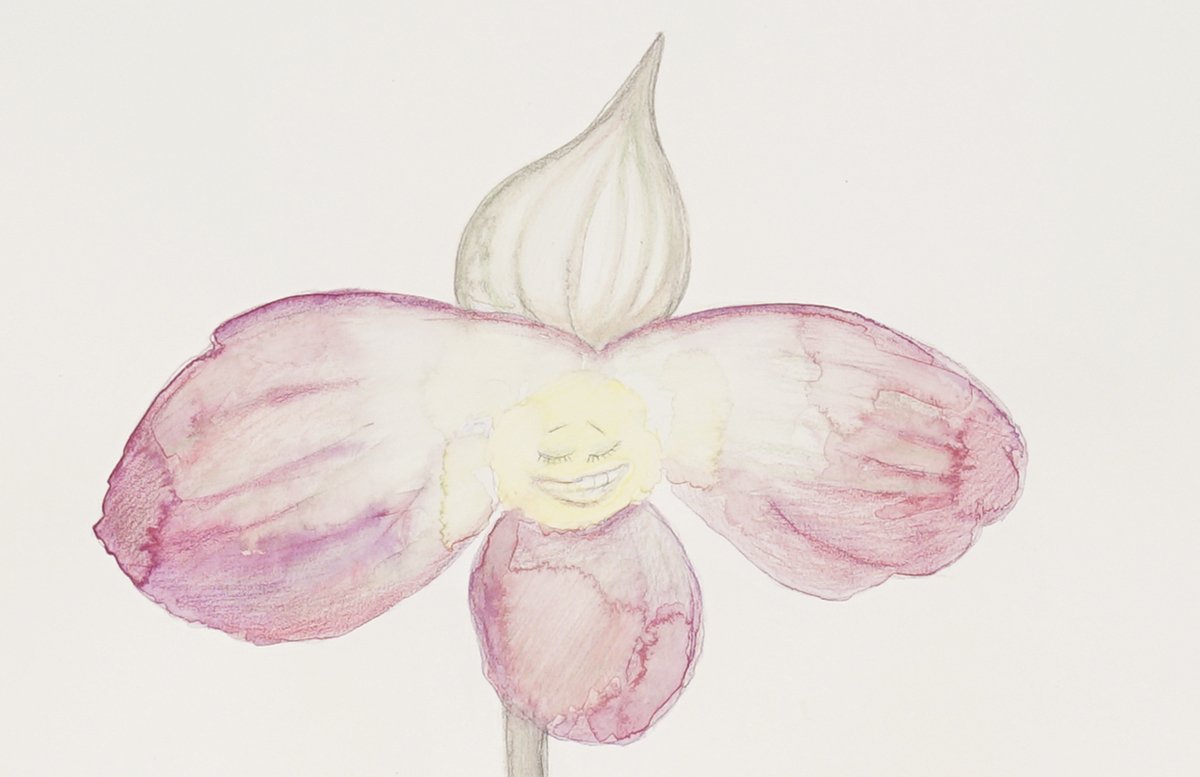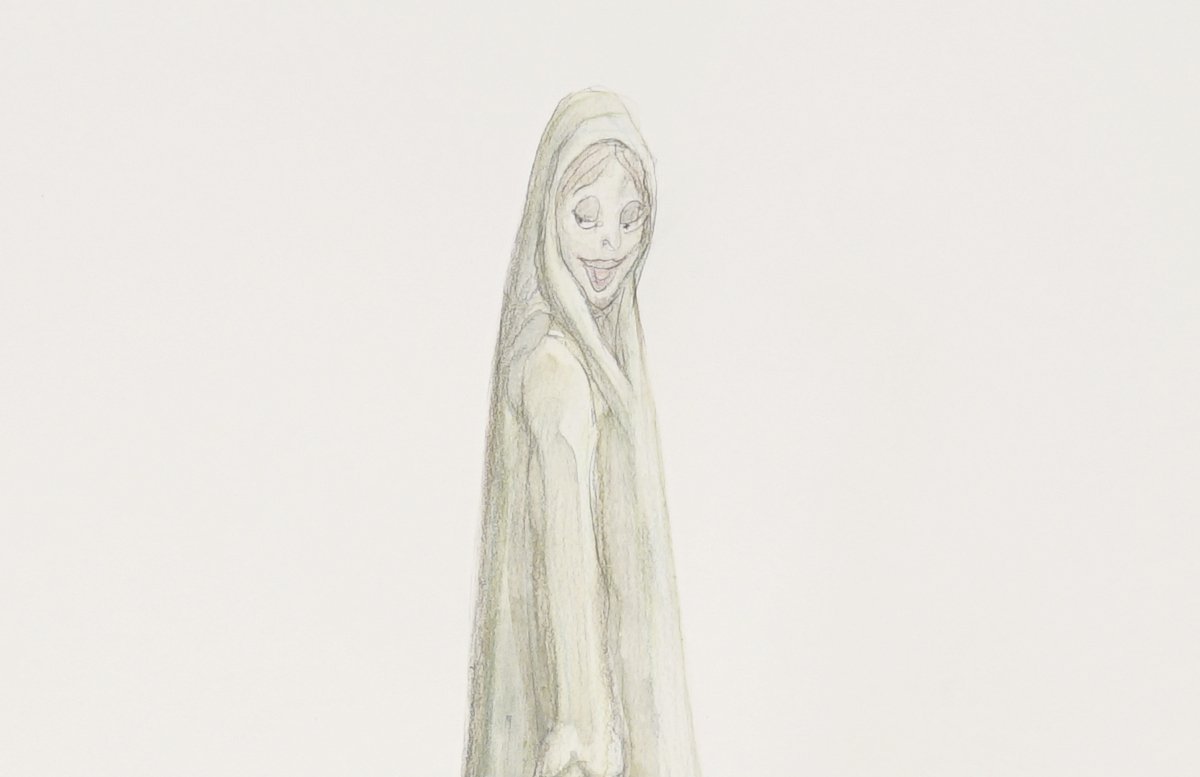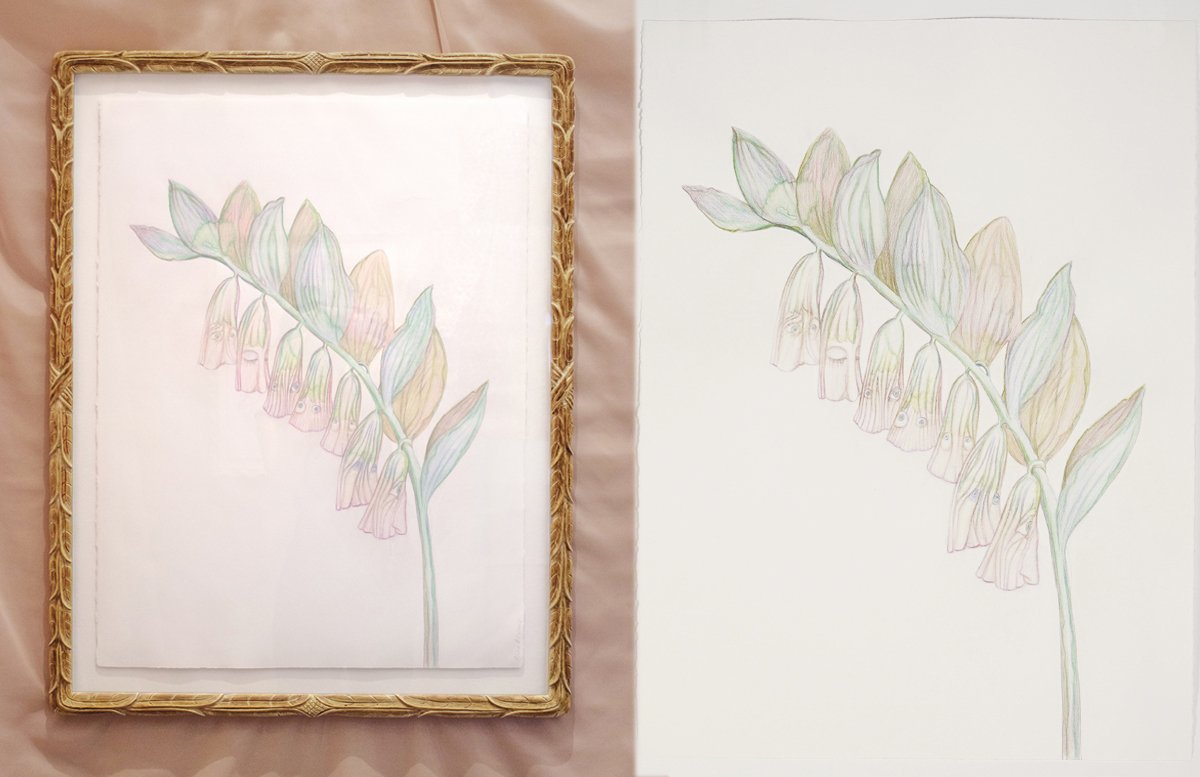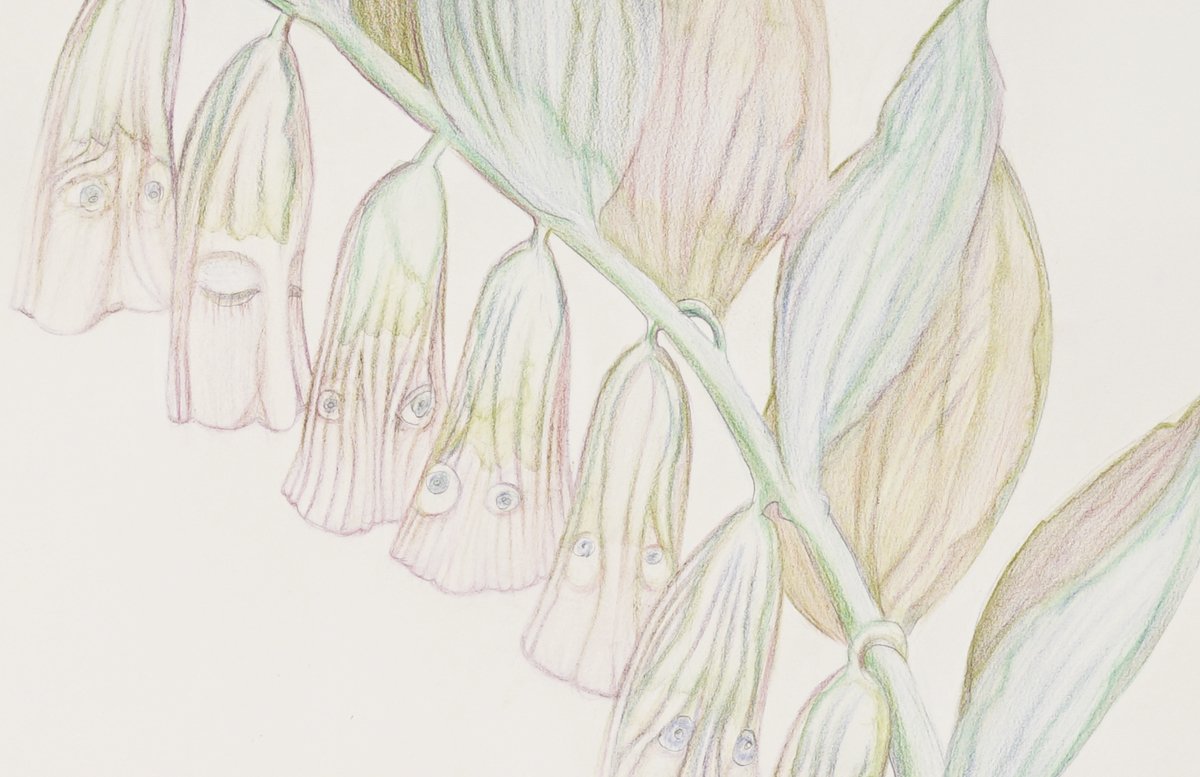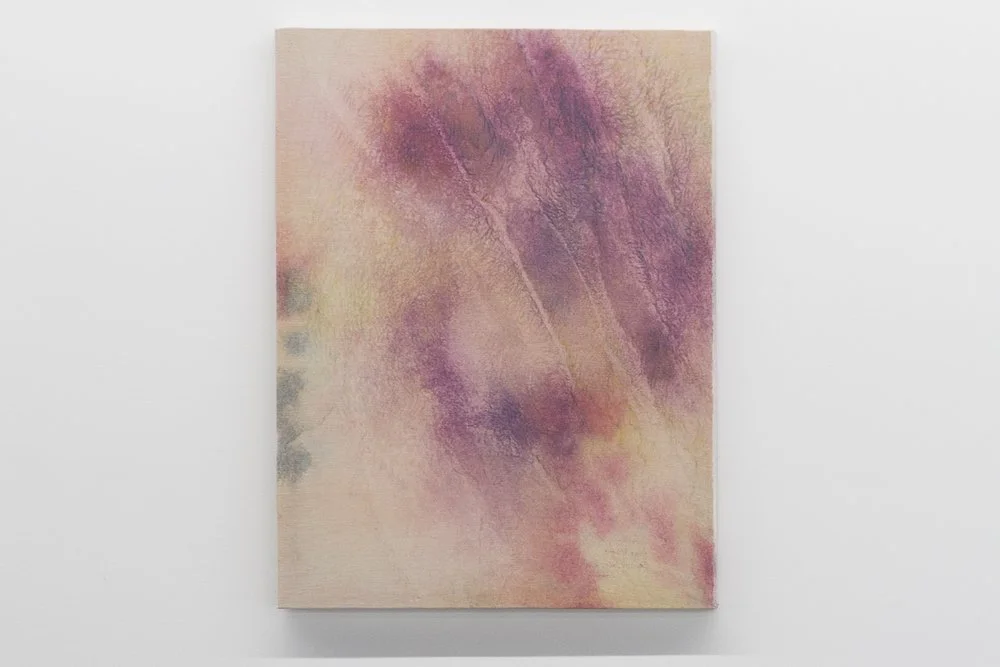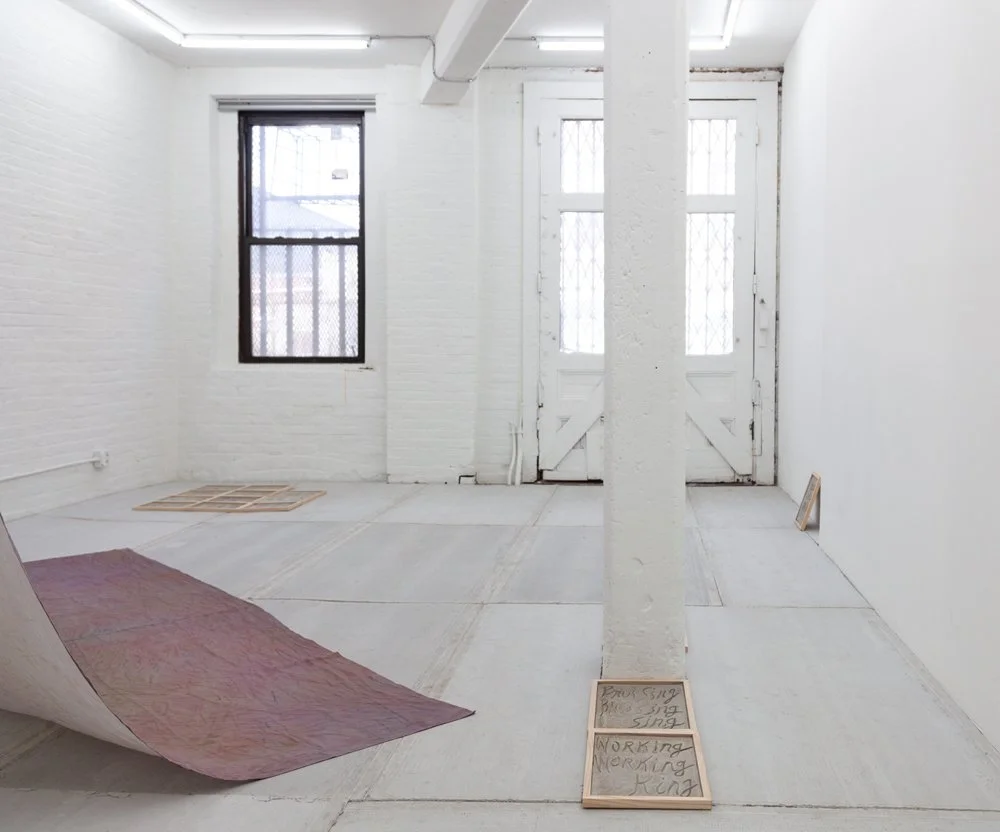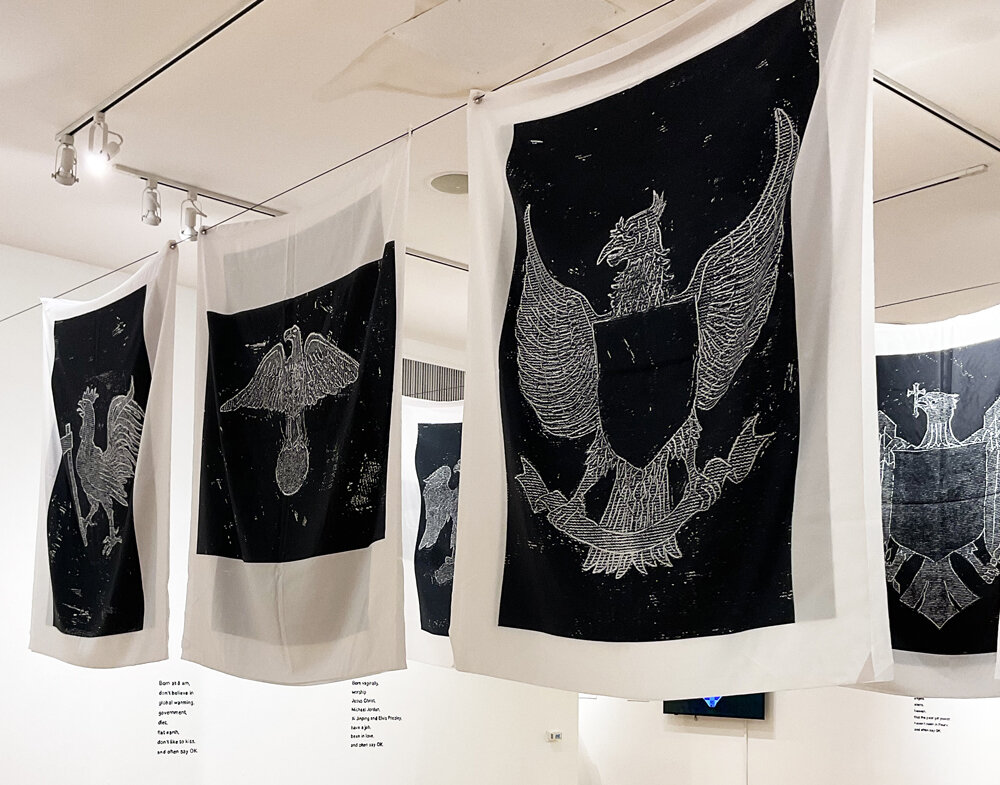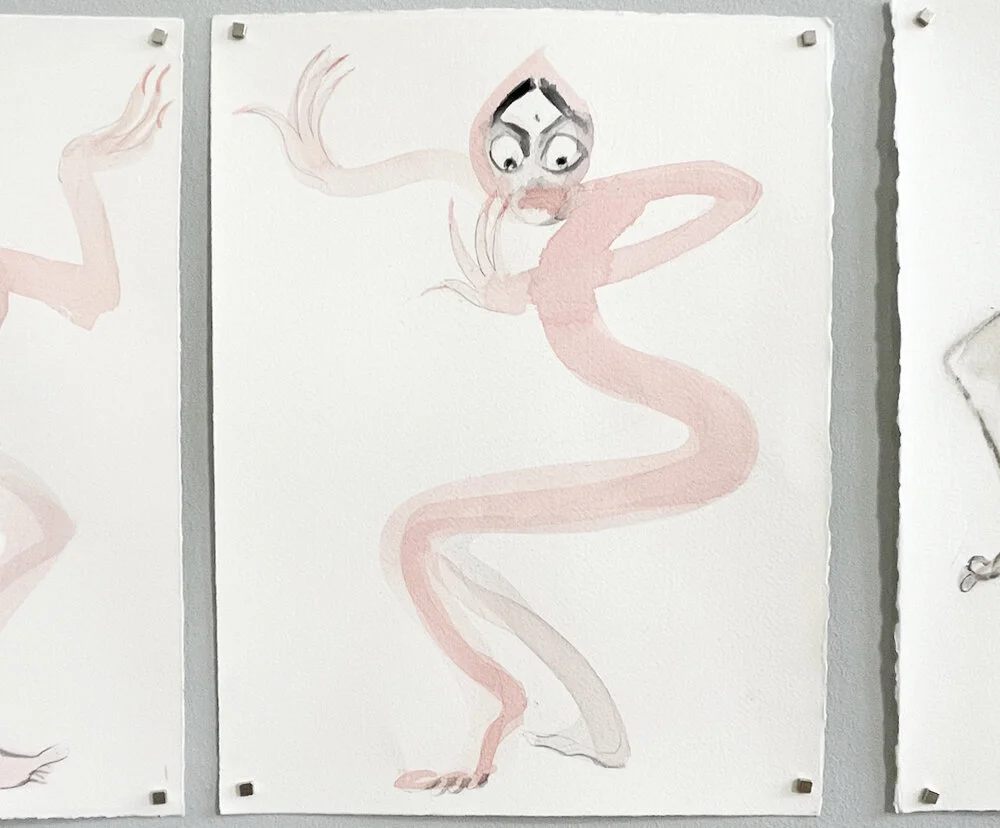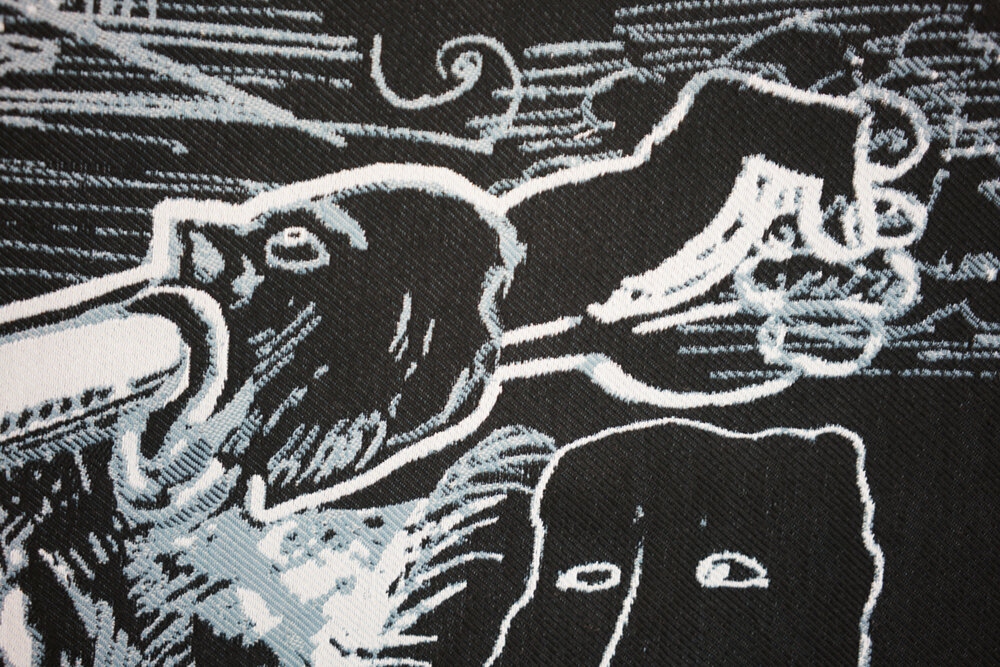COLLECTIVE BRAIN
curated by Sozita Goudouna
The Opening Gallery
42 Walker St. NYC
October 4th - November 27, 2022
Installation view: JELLYFISH VS. NUCLEAR SHIP and Other Animal Strike Tales, 2022, series of 8, watercolor and watercolor pencil on wood panel, artist’s wooden frame
Opening Gallery is pleased to announce Collective Brain, a group exhibition of works by Alina Bliumis, Jeff Bliumis, Veronique Bourgoin, Alexandros Georgiou, Mat Chivers, Raúl Cordero, Yioula Hadjigeorgiou, Steven C. Harvey, Peggy Kliafa, Artemis Kotioni, Jessica Mitrani, Paula Meninato, Eleni Mylonas, Margarita Myrogianni, Warren Neidich, Alexander Polzin, Dan Reisner, Juli Susin, Dimitris Tragkas, Adonis Volanakis, Hans Weigant, Vasilis Zarifopoulos curated by Dr. Sozita Goudouna. Installed across the first floor of 42 Walker St, Collective Brain attempts to challenge our perception of mental processes with an arrangement of corporeally provoking art pieces, connecting artists who work in divergent media and are convening from diverse localities.
Contemplating the notion of the mind as a mechanism – a brain system responsible for spatial memory and navigation – Collective Brain offers different viewpoints about the brain and its million neurons by centering neurodiversity as the fundamental concept about how we can understand the physical and biological origins of human emotion in the brain, as well as the conception, exhibition, and reception of the artworks. A section of the exhibition also attempts to comprehend and challenge perceptions about the operations of the non-human brain.
The revolutionary field of optogenetics allows us to decipher the brain's inner workings using light, however, we still seem to know little about the human mind and certain theorists argue that it is much too complicated to be controlled, while brain and electrostimulation experiments of the 60s and 70s were often unable to clarify which parts of the brain are stimulated by stimoceivers or electro-magnetic radiation.
Further to the notion of mind control, current scientific research attempts to illuminate the biological nature of our inner worlds and our “projections” namely the ways aspects of the self are experienced by the individual as residing outside the self (Deisseroth K.). Drawing from Santiago Ramón y Cajal, the founder of modern neuroscience, and his claim that “knowledge of the physicochemical basis of memory, feelings, and reason would make humans the true masters of creation, that their most transcendental accomplishment would be the conquering of their own brain,” the exhibition attempts to trace the visualization of the brain's inner circuitry with a deep empathy for mental illness.
Cajal ventured into science as both an artist and a pathologist, while he became the first person to see a neuron. The scientist visualized the inner workings of the mind with thousands of stunning pen-and-ink diagrams and his exquisite, meticulous drawings of neurons in the brain and spinal cord proved that every neuron in the brain is separate and that neurons communicate across synapses.
There is an on-going parallel between the ‘visualization of the brain’ in the scientific and in the artistic domains and a fascination with the visualization of the neurons, but how can this visualization help us understand the invisible synapses of the collective brain and especially the ways human societies can resist mind control with actual free will.
IMPRESSIONS OF THE FLOWERS THEMSELVES
Curated by Chiara Mannarino and Francesca Pessarelli
Spring/Break Art Show, 625 Madison Avenue, New York, NY 10022 Booth # 1041
September 7th - 12th, 2022
Alina Bliumis, Joseph Liatela, and Joey Rosin
New York, NY | August 26, 2022 – This September, Curators Chiara Mannarino and Francesca Pessarelli present Impressions of the Flowers Themselves, which takes botanist and cyanotype photographer Anna Atkins’ deep connection and consideration for her botanical subjects as its point of departure. Alina Bliumis, Joseph Liatela, and Joey Rosin align with this empathic relationship to plants and, each in a different way, address the symbolic potential of flowers and their ability to evoke ideas of rebirth, transformation, and utopia.
Bliumis is a research-based artist who approaches historical and political moments through the lens of the natural world. In her series Endangered: Portraits of Flowers, Bliumis gives renewed life and agency to endangered and extinct flowers through portraiture. Hand-carved frames imbue these plants with a sense of personhood and reflect the histories and mythologies associated with them. Many of the flowers Bliumis includes in this series have medicinal or psychedelic properties – their healing and transportive capabilities often leading to their exploitation and extinction.
Liatela is a multidisciplinary artist who uses performance and sculpture to address trans and queer subjectivities and embodiment. His work considers the historical use of flowers in memorials and their inherent symbolism of death and rebirth. In his installation Untitled (Ascension), Liatela applies these concepts to the body, addressing the transitory nature shared by plants and humans and one’s ability to transform over time. His work serves as an altar upon which we commemorate the individuals and parts of ourselves we have lost while looking towards the infinite potential of the reborn self.
Rosin is a musician, sound healer, and budding scent artist. In line with Bliumis’ and Liatela’s exploration of ephemerality and loss, Rosin has created a four-piece sonic landscape entitled Bardo – a Tibetan word that describes the liminal space between death and rebirth. Also by Rosin is Altarpiece – a unique fragrance that will be diffused throughout the exhibition space. Rosin has poetically conceptualized these works as a metaphorical diptych. Harnessing the evocative nature of scent and sound, Rosin’s aim is to encapsulate the beauty of a natural world that no longer exists and will never exist again.
Born in the wake of the Age of Enlightenment, during which historically prevailing notions of the self came into question, Anna Atkins turned such inquiries to the botanical world as well, considering how flora, too, can constitute moral agents. Impressions of the Flowers Themselves seeks to blur and make arbitrary the line between human and botanical life, speaking to the impossibility of extricating ourselves and our ideals from the natural world and its mythologies. The exhibition will act as an altar, a memorial, a meditative space where we can imagine an alternate present, one in which we haven’t lost these literal and figurative flowers and the stories and values they carry with them.
BETWEEN TEXTS AND TEXTILES
Bienvenu Steinberg & Partner
35 Walker St. NYC
July 21 - August 31, 2022
Alina Bliumis, Elvire Bonduelle, Mia Enell, Fernanda Fragateiro, Ann Hamilton, Analia Saban, Suzanne Song, Julianne Swartz
Bienvenu Steinberg & J is pleased to present Between Texts and Textiles, an exhibition including eight international artists. The works featured stretch the fabric of reality, from text to textile, from pattern to language. What is presented is a gradual approach to painting, sculpting, weaving and writing by visual fusion of what might be called the textile sign. The works break the link between vehicle and destination: textiles to be read with no intention of being informed, texts with no plot and no point.
Language and text are at the tactile and metaphoric center of Ann Hamilton’s work. She uses common materials to invoke particular places, collective voices, and communities of labor. What are the places and forms for live, visceral, face-to-face experiences in a media saturated world? In Shell, an homage to Joseph Beuys, in the form of a white felt coat, as well as in a groupof collagesonbookendpaper,therelationsofcloth,touch,motionandhumangesture give way to dense materiality.
In her re-reading of twentieth Century avant-garde practices, Fernanda Fragateiro frequently repurposes already-existing and symbolically layered material, in order to fashion delicate work criss-crossed by an intricate web of inner references to the history of art and architecture. Her ongoing Overlap sculptures are made of stainless steel supports and handmade fabric-bound sketchbooks. Overlapping is an important word to talk about the essence of all these works: overlapping of elements, overlapping of materials, overlapping of histories, and time overlapping. In a new series of paintings titled Poly-Grounds, Suzanne Song creates multifaceted dimensions that blur the boundary between illusion and reality. The paintings’ shapes are direct extractions of the marginal spaces delineated from previous bodies of work. The placement of shadows disrupts the flat picture plane and transforms the two-dimensional surface into an ambiguous field: are we looking at a painting, a very finely woven fabric or a polished surface?
Visions, inspired by dreams, surrounding life, or drawn from the unconscious, are at the heart of Mia Enell’s paintings. She plays with words through images, her figures of speech are free associations on canvas. Loosely Knit is a literal rendering of its title: a system of interconnected discrete units freed from instrumental utility or significance. Alina Bliumis’ text-based sculptural works, Concrete Poems, recall street wall scribbles, graffiti, and absurdist poetry. They consist of words literally inscribed on tablets of wet concrete. Border/Order; Textile/Tile; Lover/Over: the playfulness of crossword puzzles often leads to unexpected existential interrogations. Usingreadymadeexpressionsorrepetitionsofasingleword,ElvireBonduelle utilizes a repertoire of images and objects with apparently joyful potential. Made of words carefully calligraphed -in her own hand-designed font- over colorful wave patterns, Bonduelle’s paintings revel in their own obviousness.
Analia Saban dissects and reconfigures traditional notions of painting, often using the medium of paint as the subject itself and the canvas as a medium rather than a support. Her methods such as unweaving paintings, laser-burning the canvas, molding forms or weaving paint through linen thread, remain central to her practice, as she continues to explore tangible materials in relation to the metaphysical properties of artworks. Julianne Swartz articulates an architecture of frailty. When viewed, her sculptures are activated slightly, at times, they even appear to breathe. Zero blanket is a silent tapestry, made from hair-thin copper wire. The tenuous lines from the irregularly weaved structure delineate and hold space until emptiness becomes substance. Zero Blanket embodies invisible presence and tangible absence, it engages a palpable vulnerability.
CARRYING THE WEIGHT, WAR LANDSCAPES
curated by Sozita Goudouna
The Opening Gallery
42 Walker St. NYC
July 13 - September 10, 2022
Carrying the Weight, War Landscapes is a series of watercolor-on-linen landscapes. The locations were selected based on their historical significance and metaphorical representation in contemporary culture.
Each landscape immerses the viewer in tranquil scenery: a palette of green meadows frames the shallow red waters of the Rubicon River, just south of Ravenna, Italy; a starry night shines into the sea north of Tsushima Island in Japan; a cool and ghostly morning mist fills a Waterloo field in Belgium; a florid orange sunrise floods warm light over the Berezina River in Belarus; the midday sun sends its beams over the rocky Golgotha hill near Jerusalem, Israel; a golden hour brings magical light to the sky over field-lines of Austerlitz in Slavkov u Brna, Czechia; Mannahatta blooms with foliage and dramatic pink clouds hang over Mahicantuck, on the Hudson River; and the dreamy landscapes of Andes lie still in the Catskills region in upstate New York.
No visual trace remains of the dramatic historical events that took place against these backdrops: no Caesar or Napoleon with armies in tow, no horses or warships, no crucifixions; no ravages of war, nor signs of revolt. Only the place-names call to mind these histories, inviting the viewer to imagine their personal battles in place of the old. One thinks of crossing a real-life Rubicon, or point of no return; of an encounter with one’s ultimate obstacle—a Waterloo, of sorts; of feeling unavoidably defeated, as if in the gloom at Austerlitz; of failure— “c’est la Bérézina,” one might cry in French; of an occasion of great suffering figured as Golgotha, or of a battle with the ghosts of memory, animated in Tsushima.
The Lenape people inhabited the land on which I work for thousands of years before the European settlers arrived. They named their island home “Mannahatta,” meaning “Island of Many Hills.” We use the term “Mannahatta” to refer to the island as it was in 1609, and “Manhattan” to refer to the metropolis of today. The river we call the “Hudson,” the Lenape knew as “Mahicantuck,” meaning “river that flows two ways.”
BORDERS AND BRUISES
Anna Zorina Gallery Los Angeles
734 East 3rd St, Los Angeles, CA 90013
June 2 - July 9, 2022
Opening Reception: Thursday, June 2, 5-8 PM
ALINA BLIUMIS
Borders and Bruises
Anna Zorina Gallery is pleased to inaugurate its new Los Angeles Gallery space with the solo exhibition of Alina Bliumis, Borders and Bruises. This is Bliumis’ first show with the Gallery. The exhibition will feature three bodies of work including the watercolor maps of Nations Unleashed, the abstract paintings series Bruises and text-based sculptural works Concrete Poems. A percentage of proceeds from the exhibition will be donated to Direct Help For Ukraine and BYSOL, an organization supporting politically repressed Belarusians.
Bears, eagles and octopi have been active role-players in satirical maps since the 16th century. With her watercolor series, Nations Unleashed, Bliumis pays homage to cartographic curiosities by employing animal symbolism to convey biting political critique. In Bear vs. Nightingale, European countries become a battleground of zoomorphic shapes. Here the national animals are seen in mid-clash as the Ukrainian nightingale faces the Russian bear, an eagle representing the West stands alert. Bliumis explores this history of transferring human actions and motives onto primal beings to remove individual responsibility and agency from the political theater. This shift in perspective heightens awareness to this rampant strategy of displacement, compelling us to critically reflect on the Mine line that separates fact from fiction in global geopolitics.
Before maps are drawn, history is first recorded on bodies through experience captured in the form of bruises, wounds, calluses. The body is a document of social struggles. For example, in the artist’s native country of Belarus, the nation united in response to the rigged election of 2020. These protestors shared the resulting scars of having faced aggressive measures of suppression and brutal detainment across various media platforms, bringing public awareness to the human rights abuse in hopes of achieving justice in the future. These events have triggered Bliumis’ watercolor on linen series, Bruises. Each bruise painting is numbered in reference to statistics of human suffering. The traumas range from serious to playful, from political prisoners and refugees to unrequited celebrity crushes. The artist represents the bruises as abstract patches of watercolor allowing the pigment to bleed into the weave of the linen in a style reminiscent of Color Field painting. Bliumis engages the expressionist style’s association with making an emotional impact through clarity of color and form with an emphasis on celebrating individual expression and freedom of subjectivity. Her paintings are spatial and alive to endow an immortality to the feelings and sensations that underlie these important moments throughout our own personal and collective history.
If the border is what you fight for and body what you fight with, then poetry in life is a tool for survival. The works within the Concrete Poems series depict a literal approach to a visual poetry tradition that takes on a specific typographic arrangement to convey meaning. Inspired by street wall scribbles, grafiti, and absurdist poetry, the artist makes her mark firmly in concrete. Breaking down words into a context that brings new meaning or finds irony in everyday language, Imagination Nation; Mother Other; Father Her; Slaughter Laughter. Bliumis exploration of her second language of English finds that even one letter can make all the difference.
The exhibition is accompanied by text written by art critic, media theorist, and philosopher, Boris Groys.
ALINA BLIUMIS (b. 1972, Minsk, Belarus) lives and works in New York. She received her BFA from the School of Visual Art in 1999 and a diploma from the Advanced Course in Visual Arts in Fondazione Antonio Ratti, Como, Italy in 2005. Bliumis has exhibited internationally at the Musée national de l’histoire de l’immigration, Paris, France, the First Moscow Biennales of Contemporary Art, Moscow, Russia; Busan Biennale, Busan, South Korea; Assab One, Milan, Italy; the Bronx Museum of the Arts, New York, US; Galerie Anne de Villepoix, Paris, France; Centre d’art Contemporain, Meymac, France; the James Gallery at The Graduate Center CUNY, New York City; Museum of Contemporary Art, Cleveland, Ohio; Museums of Bat Yam, Bat-Yam, Israel; the Jewish Museum, New York City; the Saatchi Gallery, London, UK; Botanique Museum, Brussels, Belgium; the Victoria and Albert Museum, London, UK; MAC VAL - Musé e d’art contemporain du Val-de-Marne, Paris, France.
Her works are in various private and public collections, including MAC VAL - Musée d’art contemporain du Val-de-Marne, Paris, France; Musée national de l’histoire de l’immigration, Paris, France; The Victoria and Albert Museum, London, UK; Moscow Museum of Modern Art, Russia; Bat Yam Museum for Contemporary Art, Bat-Yam, Israel; The Saatchi Collection, London, UK; The Harvard Business School, Boston, MA; The National Museum of American Jewish History, Philadelphia, PA and Missoni Collection in Italy.
Boris Groys
ART HISTORY OF VIOLENCE
We are accustomed to living in a disenchanted and designed world – the world of administration, technology, geographical maps, statistical data and abstract painting. In this world almost all wild forms of life are already domesticated and put under control: tigers and lions live in national parks or in zoos. However, there remains suspicion that some strange, alien forms of life are concealed under the familiar surfaces of our world and cannot be totally suppressed. In the polytheistic myths of ancient cultures the flows, woods and mountains became animated. And through this act of animation they became also dangerous and violent. In her art Alina Bliumis applies the same act of animation on the familiar images of our lifeless, soulless, administered world. As a result, the hidden energy of violence and aggression becomes revealed upon which those images owe their aura of tranquility and peaceful stability.
Indeed, when we look at the political map of the world, on which every country is presented by a certain geometrical form, we tend to forget that this form is always a result of bloody wars and oppression. In her series “Nation Unleashed” Alina reveals the “animal” energy of hate and aggression to which contemporary countries owe the shapes of their borders. She shows the peaceful surface of our world as camouflage concealing the violent fight for dominance. Of course, as an artist of Belorussian origin Alina cannot turn her eyes away from the eruptions of violence that currently take place in her region. However, long before these actual events took place, she was attentive to, what one can call, the political zoology of our contemporary world –the descent of national political symbols from mythical animals of the polytheistic past.
Alina’s disbelief in the surface characterizes her series “Bruises.” Images on their surface that look to be late examples of abstract expressionism become revealed as images that remain on human skin after a punch. Here again peaceful art for art’s sake suddenly turns into a document of physical violence and the fate of the body in the contemporary world. And in the series “Concrete Poems” familiar words that seem to be merely vehicles of ordinary communication begin to dissolve, revealing an abyss of the absurd hidden behind their grammatically correct surface.
Theodor Adorno famously said that to write poetry after Auschwitz is impossible. The appearance of the beautiful would only serve as cover making us forget the cruel reality of our world. Many artists reacted to this challenge by making their artworks look as ugly as reality itself. However, in this way they missed the cruelty of the second degree – the cruelty of the aestheticizing cover-up. It is this cruelty of the second degree – the cruelty inherent to the artistic practice itself – that Alina makes her topic in a subtle and at the same time surprisingly direct and convincing way.
*The exhibition Borders and Bruises at Anna Zorina Gallery, LA is accompanied by text written by art critic, media theorist, and philosopher, Boris Groys.
Alina and Jeff Bliumis CULTURAL TIPS FOR NEW AMERICANS
curated by Sozita Goudouna, Occupy Art Project
The French Consulate, NYC
February 17 - March 9, 2022
Alina Bliumis, Jeff Bliumis
CULTURAL TIPS FOR NEW AMERICANS
2022, 110 objects, wood and ink
For the last years, we have been gathering tips on “how can immigrants blend in the American society“ using street questionnaires, handbooks, social media and public forums. Concurrently, we collected ethnic wooden souvenirs, which radiate a certain fetishization of otherness, from all around New York City and sandblasted these objects to remove their original decorations and uncover the wood underneath. The cultural tips are then written onto the wooden souvenirs in ink, causing them to become decontextualized objects, much like the immigrants to whom the cultural tips are addressed.
IMAGINATION NATION
Elma, 216 Plymouth St. Brooklyn, NY
October 23 - November 30, 2021
“First, there is the old truth that ‘In the beginning is the body,’ with its desires, its powers, its manifold form of resistance to exploitation. As is often recognized, there is no social change, no cultural or political innovation that is not expressed through the body, no economic practice that is not applied to it.’”
— Silvia Federici “Beyond the Periphery of the Skin” 2020.
Entering the gallery, a visitor met by a floor to ceiling colorscape, hanging under its own weight, a linen from the artist series “Bruise.” Alina started the series last year, responding to the violence and battered bodies on the news coming from her birthplace Belarus. On August 8, 2020 the nation came together in unprecedented unity to protest against the rigged presidential election of the man who has held power over the last 26 years, Alexander Lukashenko. Thousands of peaceful protesters looking for justice poured to the streets where they were met by authorities conducting indiscriminate beatings and brutal mass detentions, and dispersing crowds with truncheons, stun grenades, and water cannons. Over the following weeks, protesters made their battered bodies public to record the evidence of a human rights crisis in the country. Lukashenko claimed that the opposition fabricated the abuse and “girls painted their butts with blue color.”
“Bruise #16” (2021) watercolor on printed linen was created for this exhibition. Beneath it lies the text-based and site-specific work “Concrete Poems” covering the floors of the gallery. Alina brings together art historical references such as Dada and Brazilian “Concrete Art” and the literal interpretation of concrete poetry inspired by city scribbles, graffiti, and absurdism.
One of the poems reads Imagination, Imagination, Nation.
*installation view photos by Ege Okal
AMATEUR BIRDWATCHING AT PASSPORT CONTROL and MOST OF US ARE at TO SCATTER OR SOW: DIASPORA IN CONTEMPORARY ART
Curated by Elizabeth Hoy
Beard & Weil Galleries, Watson Fine Arts, Wheaton College
September 7– October 23, 2021
To Scatter or Sow: Diaspora in Contemporary Art serves as a central event for Wheaton’s campus-wide initiative to consider Diasporas: Economies, Boundaries, and Kinship. The title of the show is taken from the Greek root of the word, and evokes not only the dispersal inherent in diaspora but also the potential for rich growth. Framing the multi-faceted idea of diasporas through the work of eight contemporary artists, the exhibition includes video, photography, painting, ceramics and text-based work. The exhibition is presented both virtually and on the Wheaton campus. Artists: Alina Bliumis, Chinatown Pretty: Andria Lo & Valerie Luu, Isabella Cruz-Chong, Patricia Encarnación, Michael Gac Levin, Jodie Lyn-Kee-Chow, Crys Yin.
DANCE AS A WEAPON at WHAT MAKES ANOTHER WORLD POSSIBLE?
Curated by Corina L. Apostol
Kunstihoone Tallinn, Estonia
September 18 – December 5, 2021
Installation view: Dance As a Weapon (2020 “Studies in Movement Across National Ideologies of War and Resistance” series of 70 works, watercolor on paper, dimensions variable) at What Makes Another World Possible? curated by Corina L. Apostol, Kunstihoone Tallinn, Estonia, photo #1-2 by Paul Kulmet
On Friday, 17 September, an exhibition entitled What Makes Another World Possible? will open at Tallinn Art Hall, which looks at socially engaged art in the last decade and the role of art in social and political struggles. The exhibited works provide an overview of how art has been used as a tool for shaping society in the last decade.
Corina L. Apostol, the curator of the exhibition, remarks that when compiling the exhibition she was guided by the belief that artists contribute to some of the most crucial debates of our times and that their voices are significant in shaping society and imagining how it could be different. “The work of the artists in this exhibition brings together the various facets of art, activism and global politics,” she says.
The exhibition includes works by 14 artists or groups from Estonia and abroad: Alina Bliumis, Zach Blas, Chto Delat?, Vala T. Foltyn, Núria Güell, Sandra Kosorotova, Kristina Norman, Daniela Ortiz, Tanja Ostojić, Lia Perjovschi, Dan Perjovschi, Dushko Petrovich, Urmas Viik and Ala Younis.
Corina L. Apostol is the co-author of Making Another World Possible (Routledge, Creative Time), which was published in 2019. Both the book and the exhibition examine ten global issues through the prism of socially engaged art projects, including: the militarisation of society, the proliferation of surveillance, entrenched economic inequalities, rising social movements, the displacement of peoples, cosmopolitics, anti-racism struggles, creative education in crisis, queerness and political expression, and new devices enabling political action.
“The global pandemic has only amplified many of these urgent issues, and interest in socially engaged art has grown: it has moved from the margins of the art world to being a central part of the discussion on contemporary art and politics,” Corina L. Apostol says.
Rather than attempting a global survey, the adaptation of this book into a physical exhibition seeks to raise fundamental questions that initiate conversation and contribute to the understanding of socially engaged art both in Estonia and abroad. The exhibition gives an idea of which current issues speak to artists and how art is responding to the present political questions and relating to the global situation here and now.
The exhibition combines different yet interconnected artistic notions and is not only a place for presenting art, but also a space for learning and exploring. Together with the exhibition, Tallinn Art Hall is launching a unique series of successive educational programmes for students of general education schools, entitled School of Perception. Further information on the website of Tallinn Art Hall.
Choreographers Joanna Kalm and Nele Suisalu will give a performance at the opening of the exhibition at 6:30 pm, entitled Myrtle Sisters: To Health.
ALINA BLIUMIS, THE CAMOUFLAGE OF LAUGHTER
Curated by Cash (Melissa) Ragona
SPRING/BREAK Art Show NYC, 2021 / HEARSAY:HERESY
Alina Bliumis’ The Camouflage of Laughter (2020-2021, tapestry, series of 4 panels, overall dimension 29" X 432” ) uses the grotesque, power-switching apparatuses of Medieval festivals and pageants as its starting point, but pushes this paradigm up against contemporary forms of contested political representation. Her Jacquard loom-woven tapestry forms a continuous frieze, confronting viewers with the tensions and ecstasies of social bodies.
At first, we were tempted to call this project, Feast of the Ass—pointing back to the Medieval, Christian festival/ceremony that worshipped biblical donkeys, but especially the particular “ass” that was thought to have carried Mary, pregnant with Jesus, into Egypt (fleeing from the campaign to murder young boys led by the despot, Herod the Great). As Mikhail Bakhtin describes it, along with its sister pageant, Feast of Fools—Feast of the Ass exhibited many of the central tenets of what he terms, the carnivalesque: ritual spectacles were staged, often comic, even raucous, in nature, i.e., the priest, situated next to the celebrated donkey on the altar, would often “bray” his sermon and the congregation would “hee haw” back their replies. Or, on the way to the church, a pregnant girl, holding a faux baby (doubling/confusing real and fictional instances of fertility) would ride the donkey, while bystanders sang bawdy songs of praise to the ass. These religious feasts were often accompanied by fairs that included amusements of all sorts, including a motley crew of entertainers “with the participation of giants, dwarfs, monsters, and trained animals” (Bakhtin 1968). Clowns and fools would make appearances, play-acting as kings, queens, bishops, dukes, or exotic animals—laughter abounded. Grotesque displays of eating and normally repressed bodily functions (sneezing, farting, guffawing, snorting) took central stage. Laughter, in other words, acted as a radical camouflage for social and economic critique — allowing everyone, but especially peasants, to suspend, even if for a moment the hierarchies and seriousness of ecclesiastical, feudal, and political forms.
Alina Bliumis’s work takes Bakhtinian laughter, with its focus on the grotesque, power-switching apparatuses of Medieval festivals and pageants as its starting point, but pushes this paradigm up against contemporary forms of political representation that embrace conspiracy theories and violence at the center of their operations. Her frieze-like tapestry links together scenes of power relations upended (woman-identified figures usurping masculine-occupied positions of power, animals directing humans, buffoons commanding authority), but also displays the dangers of the carnivalistic and its propensity to harness unbridled antinomian energy for racist, misogynistic, and, even, murderous ends. The latter is displayed by one panel in which she depicts one of the mobs that led the deadly siege on the US Capitol (January 2021). Tucked in among them, one can identify a less ostentatious version of Jacob Anthony Chansley, the QAnon-supporting “shaman” who wielded a spear, wore a fur hat decorated with buffalo horns, and threatened the lives of several elected officials (claiming he was an alien, being directed to do this as a “higher being” soon to ascend Earth to another reality). Besides the shared iconography of ritual, comic displays of mixed social signifiers, Bakhtin also points to the carnival’s drive to mess with language, to drag curses, obscenities, crude fictions into “learned talk,” into civic discussions. However, what happens—Bliumis asks in her current work—when carnival becomes a camouflage for conspiracy? For paranoia? For the conflating of common sense and moral hallucination?
Bliumis’s tapestry — with a nod to actual Medieval tapestries that were dedicated to both the Feast of the Ass, as well as the Feast of Fools, will stretch around the perimeter of the room as an analog, time-based work that commits several instances of heresy. Not only will it question the “carnival symbolic” that Bakhtin so fully believed in as a way of aggrandizing the collective body as a transformative force, but it will also commit an act of anti-craft by reproducing the complexity (and labor) of handwoven Medieval tapestry via digital textiles—mirroring the viral circulation of mediated images featured. Moreover, Bliumis does not offer a conventional narrative structure of any social or moral rite of passage in this work, but rather a disjunctive, work that explores the repeating forms of gestures of resignation that have been transformed, via both on-the-ground protests, as well as the viral engines of media, into signatures of resistance.
For example, one panel depicts the “Hands Up, Don’t Shoot” meme which has become a central symbol of protests—against the escalation of police violence against black bodies—that emerged out of the Black Lives Movement. However, her approach is genealogical, rather than chronological. Simultaneously, she reaches back in time to Francisco Goya’s use of this gesture in The Third of May 1808 (1814) (depicting the Spanish resistance to Napoleon’s invading armies) and forward to a 2008 newsprint/internet image of protestors in Kenya, with their hands-up (under military police attack), opposing what they saw as the corrupt government of then elected, President Mwai Kibaki. In another panel, Bliumis depicts a young woman being arrested on the front lines of the recent female-led protests against an autocratic government in her native Belarus.
Bliumis purposefully removes the details of context throughout the tapestry — so that viewers are left with open, albeit, loaded signifiers that could be read in multiple ways. This kind of embedded tension or complex camouflage drives this urgent work.
Alina Bliumis (born in Minsk, Belarus, 1972) is NY-based artist. Alina received her BFA from the School of Visual Art, NYC, 1999 and a diploma from the Advanced Course in Visual Arts from Fondazione Antonio Ratti, Como, Italy, 2005.
Alina has exhibited internationally at the Musée national de l’histoire de l’immigration, Paris, France, the First Moscow Biennales of Contemporary Art (Russia), Busan Biennale (South Korea), AssabOne (Milan, Italy), the Bronx Museum of the Arts (NY, US), Galerie Anne de Villepoix (Paris, France), Centre d’art Contemporain (Meymac, France), James Gallery, The Graduate Center CUNY (NY, US), SPRING/BREAK Art Show (NY, USA), Museums of Bat-Yam (Israel), the Jewish Museum (NY, US), Saatchi Gallery (London, UK), Botanique Museum (Brussels, Belgium), Victoria and Albert Museum (London, UK), Tokyo Biennial (Japan), MAC VAL - Musée d’art contemporain du Val-de-Marne (France).
Her works are in various private and public collections, including MAC VAL - Musée d’art contemporain du Val-de-Marne, France; Musée national de l’histoire de l’immigration, Paris, France; The Victoria and Albert Museum, London, UK; Moscow Museum of Modern Art, Russia; Bat Yam Museum for Contemporary Art, Israel; The Saatchi Collection, UK; The Harvard Business School, USA; The National Museum of American Jewish History, Philadelphia, USA and Missoni Collection, Italy.
Cash (Melissa) Ragona is an Associate Professor of Critical Theory and Art History in the School of Art at Carnegie Mellon University, as well as an independent curator and critic. Ragona's critical and creative work focuses on sound design, film theory and new media practice and reception. By forging approaches from the disciplines of film studies, art history, and new media technologies, her work has sought to present a more complex aesthetic, theoretical, and historical foundation for the analysis of contemporary time-based arts. Her forthcoming book project, The Warhol Tapes: Beyond Readymade Sound, examines Warhol's tape-recording projects from the mid-sixties until the late 70s in light of audio experiments in modern art as well as contemporary practices of pattern matching and information visualization. Her essays and reviews have appeared in October, Frieze, Art Papers, Camera Obscura and numerous edited collections. She has also published in monographs on the work of artists, Heike Mutter, Ulrich Genth, Christian Jankowski, Carolee Schneemann, Jonas Mekas, Paul Sharits, Antoine Catala, and Angela Dufresne. Ragona has curated exhibitions and served as a curatorial consultant at various venues throughout the US, including the Mattress Factory Contemporary Art Museum (Pittsburgh), the Miller Gallery (Pittsburgh), PPOW Gallery (New York), The Hole Gallery (New York), as well as the Museum of Modern Art (New York). She is also a Board Member for the Carolee Schneemann Foundation in New York, serving as the Chair of its Media/Film Advisory Committee. She has lectured on experimental film, sound, performance and installation at Yale University, Princeton University, Tate Modern in London, the Museum of Modern Art (MoMA) in New York, Pioneer Works in Brooklyn, Electronic Arts Intermix in New York, Freie Universität Berlin, as well as The Academy of Fine Arts (KUVA) in Finland, and other venues both nationally and internationally.
ALINA BLIUMIS, CARRYING THE WEIGHT, WAR LANDSCAPES
WILLBEES, Andes NY
August 7 -29, 2021




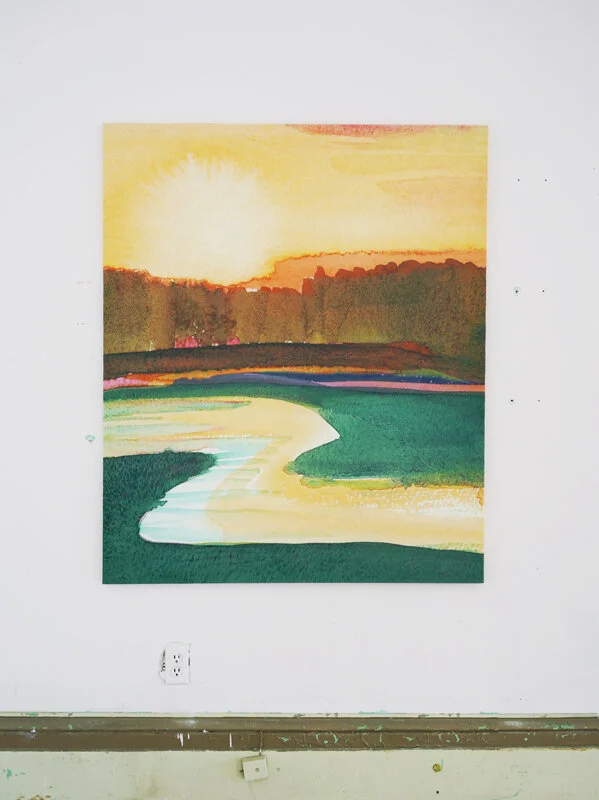



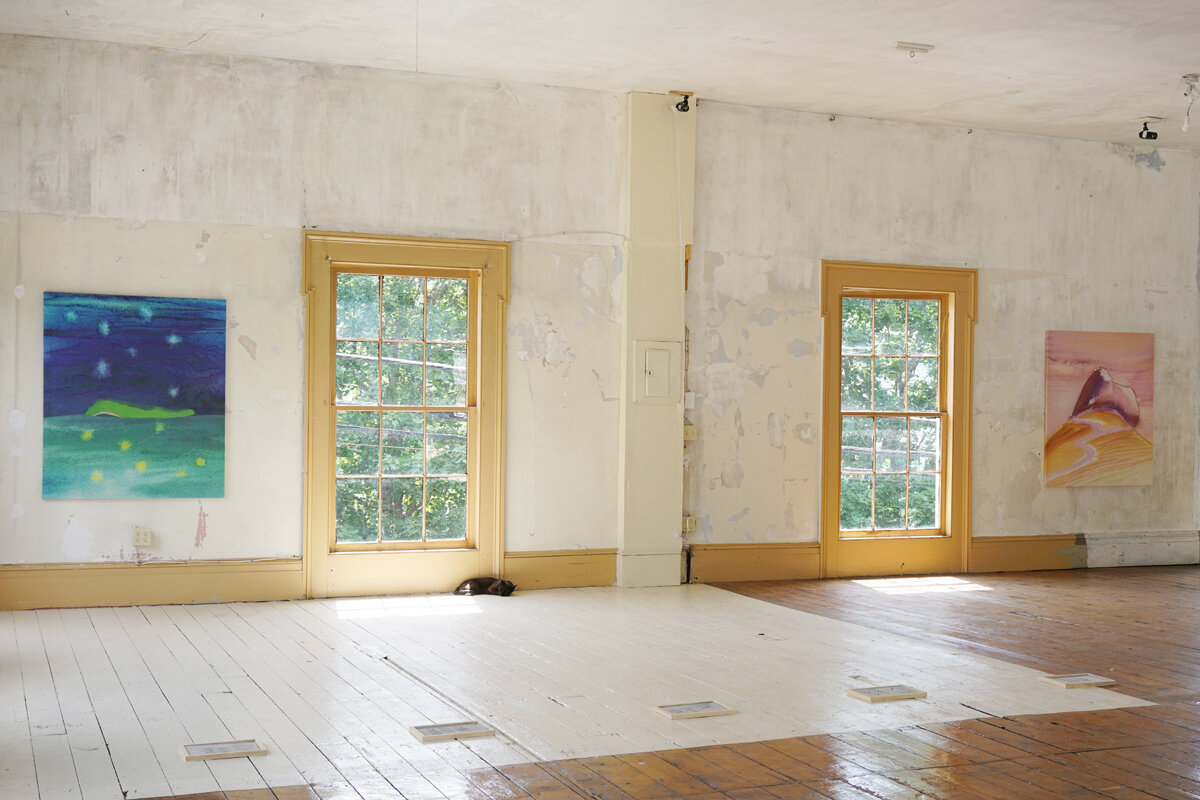











THE CLOUDY SKY
J.B. Bovina September 17th, 1845
THE MORNING OF FREEDOM! ROSE BRIGHT TO THE VIEW -
THE DAWNING EFFULGENCE OF LIBERTY’S BEAMS,
HER BANNERS VICTORIOUS, TRIUMPHANTLY FLEW
O’ER DELAWARES MOUNTAINS, HER FOREST AND STREAMS.
THE TYRANT, PATROONERY, RUSH’D ON TO HIS END,
DETESTING THE GLANCE OF HER SLAVE FREEING RAY-
THE BOARDERS BY FREEDOM BEGAN TO EXTEND,
AND DARKNESS GAVE PLACE TO THE DAWNING OF DAY.
THOUGH BRIGHT BE THE MORNING, UNCLOUDED THE SKIES,
UNDARKEN’D THE SUN, AND UNTARNISHED THE AIR -
HOW SOON CAN THE MOST OF THE MORNING ARISE,
AND DARKEN THOSE GLORIES WHICH OPENED SO FAIR.
THE MORNING OF FREEDOM! IS DIM’D WITH A CLOUD -
A FOG FROM THE PASSIONS OF MEN IS EXHALED;
HER GLORIOUS EFFULGES IS WRAPPED IN A SHROUD -
HER RADIANCE AT PRESENT IS PARTIALLY VEIL’D.
O’FOOLS! TO IMAGINE DESTRUCTION AND BLOOD
COULD BRIGHTEN THE BLOOM ON LIBERTY’S TREE;
THE VOTE OF THE FREEMAN! THE POWER UNSUBDUED,
NOW ONLY FURTHER THE CAUSE OF THE FREE.
Opens on the 176th anniversary of the most significant anti-rent war event in Delaware County, NY; the shooting of Osman “Bud” Steele at the Moses Earl Farm. The anti-rent war was fought in opposition to oppressive Landlords who represented a small group of wealthy families who leased land to tenant farmers. On August 7 1845, Anti-Renters gathered at the farm of Moses Earl about a mile and a half southeast of the town of Andes. They had heard that Earle’s cattle were to be sold for non-payment of rents and were determined to convince the posse otherwise. Steele was killed and the “War” moved into the judicial arena of the Delaware County Courts.
Alina Bliumis (born in Belarus, lives and work in NYC and Andes, NY) is presenting the watercolor-on-linen series: Carrying the Weight, War Landscapes - a gaze upon the dreamy wild fields of the Catskills mountains around her studio in Andes, the florid orange sunrise floods warm light over the Berezina River of her birth place in Belarus - or a palette of green meadows framing the shallow red-colored waters of the Rubicon River (south of Ravenna, Italy); all locations based on their historical, semiotic or metaphorical significance.
There is no visual reference to the dramatic historical events that took place in these landscapes of war’s past: no anti-rent rebellious farmers disguised as Calico Indians, no armies gathering under the direction of Napoleon or Caesar, no horses, no warships, no guns. No traces of the ravages of war, only the voice of the majestic stillness left after destruction. The geographical names allude to a historical event and signify a personal battle: crossing personal Rubicons-a point of no return, meeting one’s own Waterloo - an encounter with one’s ultimate obstacle, inevitable defeat at Austerlitz - facing gloom and “c’est la Bérézina” (translation: a serious failure).
Alina Bliumis has exhibited internationally and her works are in various private and public collections, including MAC VAL - Musée d’art contemporain du Val-de-Marne, France; Musée national de l’histoire de l’immigration, Paris, France; The Victoria and Albert Museum, London, UK; Moscow Museum of Modern Art, Russia; Bat Yam Museum for Contemporary Art, Israel; The Saatchi Collection, UK; The Harvard Business School, USA; The National Museum of American Jewish History, Philadelphia, USA and Missoni Collection, Italy.
RADICAL RURAL SOCIALISM: THE ANTI-RENT WAR talk by Jennifer Kabat, AUGUST 14, 4-5PM
As part of Andes Community Day on the Anti-Rent War. It was a time when our community was the most radical (and most violent) group in the US in an age of rage and radical reconsidering what the US could be. It’s a time remarkably like our own— if at opposite intentions. The uprising was fought across parts of Delaware County and took place in part, in my town, on my road, on my land…. I’ll talk about digging into the war's foundations in literal foundations and ruins where I live. Plus, the Anti-Rent War’s ties to other left/socialist/utopian movements from the 17th century up. (Let’s hear it for the Diggers…) Andes Community Day celebrates the shooting and death of undersheriff Osman Steele. It was the bloody apex of the Anti-Rent War, and afterwards, the governor declared Delaware County in a state of insurrection. The militia was called out and a grand jury sat for a month meeting every day but Sunday. The Anti-Rent War, which is little known had an outsized impact on the country. It led to the Homestead Act.
Jennifer Kabat’s essays have appeared in Granta, Harper’s, Frieze, The Believer, Virginia Quarterly Review and The White Review. A finalist for Notting Hill Editions’ Essay Prize, she teaches at NYU and the New School and was awarded a Creative Capital/Warhol Foundation Arts Writers Grant for her criticism. Her writing has been included in exhibitions at Arnfolfini (Bristol, UK), Index (Stockholm Sweden) and The Poor Farm (Little Wolf, WI), where her ongoing collaboration with the artist Kate Newby was featured in the summer of 2016. She is a founding editor of the essay site The Weeklings and is currently working on a book of linked essays, GROWING UP MODERN, exploring civic values from the modernist suburb where she grew up to where she lives now in the Catskill Mountains.
https://www.jenniferkabat.com
BRUISE SERIES at BELARUS - SCREAMS OF THE SILENCED
The Grey Space in the Middle, The Hague, The Netherlands
July 2021





Installation view: Alina Bliumis Bruise #15, 2021, watercolor on printed linen, 145 x 112 inches / 370 cm x 284 cm
Exhibition and public program as a gesture of solidarity with Belarusian voices of (artistic) resistance protesting against a derailed dictatorship.
Witness the historic moment of a new Belarusian society unfolding – tirelessly protesting the escalating pressures of a derailed dictatorship. To avoid persecution a clever use of language, imagery, and fill-in-the-blanks inventiveness has emerged, leading to a double art of transparency and subtlety. ‘Screams of the Silenced’ is a gesture of solidarity with Belarusian artists and all other voices of resistance in Belarus.
Be immersed in a critical polyphony while exploring deeply personal first-hand accounts, exemplified by video works, prison drawings, installations, paintings, kinetic sound sculptures, interactive performance art, as well as an extensive public program. Over 30 artists are participating in the exhibition: Tasha Arlova, Eyad Aljarod, Bazinato, Rufina Bazlova, Alina Bliumis, Alena Davidovich, Evelina Domnitch and Dmitry Gelfand, Andrei Dureika, Darya Golova, Mikhail Gulin, HeHe, Maria Komarova, Zahar Kudin, Lera Lazuk, Vika Mitrichenko, Ulyana Nevzorova, Lesia Pcholka and Uladzimir Hramovich, Ales Pushkin, Ala Savashevich, Nadya Sayapina, Artemy Sei, Jura Shust, Maksim Shved, Antonina Slobodchikova, Raman Tratsiuk, Maxim Tyminko, Ira Zabela, cultprotest.me, Polina Titova.
ALINA + JEFF BLIUMIS, A PAINTING FOR A FAMILY DINNER, TOKYO, JAPAN
TOKYO BIENNALE 2021
3331 Arts Chiyoda #104 : 3331 Gallery
July 10 - September 5, 2021




In June 2021, we placed the following call for participation via social networking sites to Tokyo residents:
“Husband and wife artist team are offering a painting in exchange for an invitation to a family dinner. Please email for more info. According to the present situation, all gatherings will be via zoom.”
In July 2021, we had dinners with twelve Tokyo families via zoom.












A Painting For A Family Dinner is a broad socially engaged artistic initiative, developed in different cultural contexts and continents. It started in Bat-Yam, Israel 2008. It was continued in the Bronx, New York, US 2012, Beijing, China 2013, Lecce, Italy 2013, and Tokyo, Japan 2021.
For A Painting For A Family Dinner project, we placed a call for participation in the media and via social networking sites to local residents: "Husband and wife artist team is offering a painting in exchange for an invitation to a family dinner. Please, email or call for more info..."
When families responded to the call for participation, we visited as many homes as we could. Participation was based on a first-come-first-served basis. There were no guidelines for our interactions, and we were open to any discussions that occurred. We created a painting for each occasion in advance. Each painting was a still life with fruits and "Thank You for Your Dinner!" written in the middle. At the end of each dinner, all participants were seated on a family couch, with the painting hung above the couch, for a family portrait--to be taken by a local photographer. The painting stayed with the family.
The project is not about a painting or a dinner, but about the displacement of the familial/familiar by virtue of artistic initiative. The project was embedded in the real life of the community and depended on the participation of local residents. The process was inclusive and welcoming for everyone in the neighborhood(s) and community(s). The artists and the families were equal and active co-creators of the project. Many members of the local cultural scene were involved in the research, creation, production and dissemination of the project in its different stages.
Altogether, we had dinners with 51 families, and here is our journey.
A Painting For A Family Dinner eliminates the artificial separation between art and life in the place of the familial/familiar. A platform for exchange and conversation is provided, overcoming the distance that normally exists between the artist(s) and audience--by establishing an opportunity for engagement with enriched and expanded forms of sociality (inter-and intra-cultural). The project embodies artistic practice as a form of civic engagement and social intervention. The project's main objective is to enable cultural and social transformation by integrating art as a reflective practice, an exchange, and a communicative experience within the everyday setting of family life.
This artistic intervention engages all participants in expanding the value and the meaning of social interaction -- as what engulfs the familial/familiar place of sharing time and food. The foundation of the project is the creation of a place or a moment where the public and the private spheres overlap and reformulate; art in the private space reshaping the public sphere itself. The other elements of the concept are openness and thankfulness; openness is about welcoming the possibilities of communication with a stranger; and thankfulness is the acknowledgment of debt and the values inherent to the potlatch, a gift-giving economic system practiced by indigenous people of the Pacific Northwest.
The long term objectives are to expand the sphere of the social experience of all those involved, by injecting extra-/intra-social/cultural/economic dimensions into the familial/familiar space; and to make the arts more meaningful in the realities of individual's lives in different societies and countries, by effectuating art as a transformative experience of co-active being and co-active thinking.
Partner organizations are Tokyo Biennale, Tokyo, Japan; Ammirato Culture House (ACH), Lecce, Italy; Inside-Out Art Museum (IOAM) Artist Residency Programme, Beijing, China; No Longer Empty, New York, US; The Bronx Museum of the Arts, New York, US; MoBY, the Bat Yam Museum for Contemporary Art, Israel.
Photography by Aya Morimoto (Japan), Alessia Rollo (Lecce), Du Yang (Beijing), Anton Trofymov (Bronx), Dafna Gazit (Bat Yam).
ALINA BLIUMIS, NARRATING AGAINST THE GRAIN
Curated by Corina L. Apostol
Tallinn Art Hall, Estonia,
July 17 - September 6, 2020




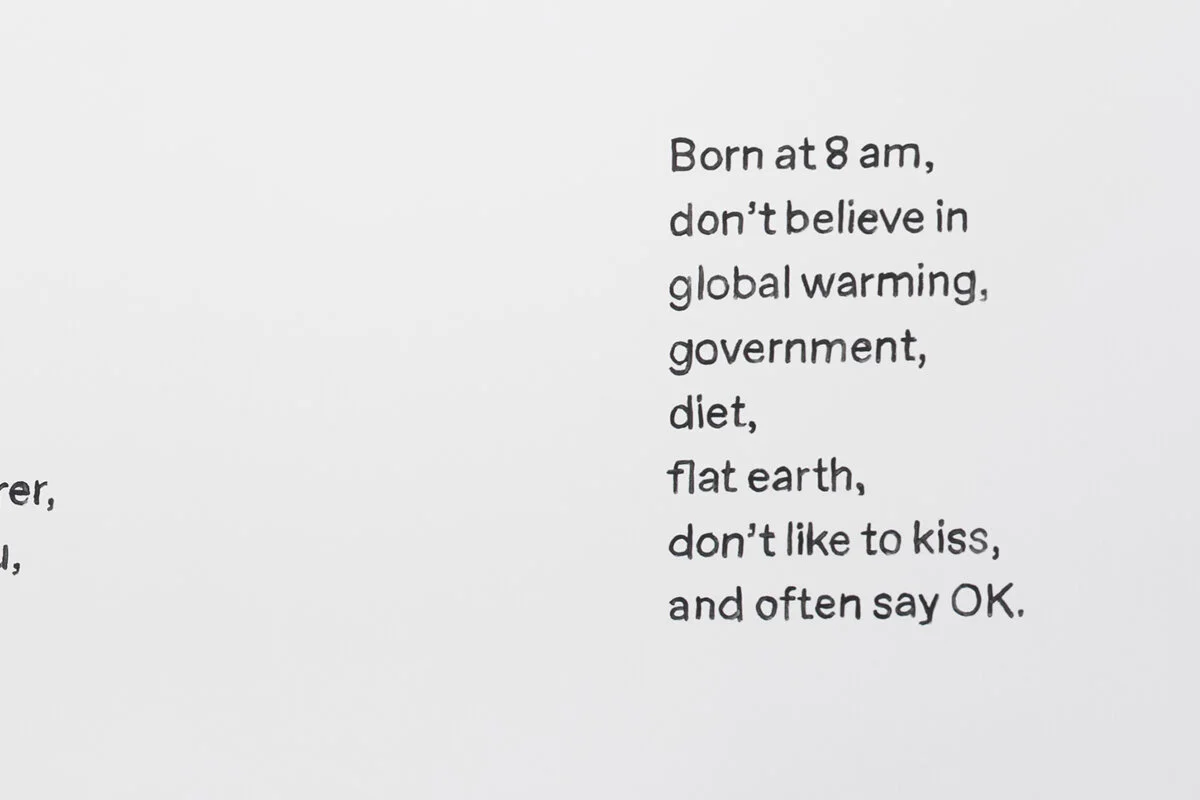






















Where would you go if you wanted to see the centre of Europe? What are the traits of the average global citizen? What happens to our families when our political views are crossed? How can differences among us be re-defined in ways that enable resistance and creative activity for cultural change?
The “Narrating Against the Grain” exhibition features new commissions by Alina Bliumis and Tanja Muravskaja and will be open from 17 July until 6 September at Art Hall Gallery. The exhibition opening will take place on 16 July at 5 pm.
“Nations themselves are narrations,” observed Edward Said in Culture and Imperialism (1993), a statement that holds true in our current time. While conflicts continue to be waged over the ownership of land (and resources), issues of who has the right to work, live, settle and travel, and indeed the question of a nation’s future, are nevertheless echoed, challenged or even decided upon in narratives, both written and visual.
This exhibition brings together two artists who share the experience of growing up in Soviet Eastern Europe as well as a thematic interest in transcending borderlines, the constructed-ness of national identity, the entanglement of art and politics and the im/mobility of migrants. The global refugee reception crisis as well as the dramatic transformations in Europe during the pandemic have been catalysts for these artists to create artistic narratives that go against the grain and engage with forms of being in-between geographies and the struggle over self.
With humour and empathy, this project, the first collaboration between artists Alina Bliumis and Tanja Muravskaja, will introduce inventive forms of togetherness at the intersection of art, politics and education. The project specifically consists of a physical presentation of photographs and interviews of life under the pandemic with at-risk, vulnerable, resilient members of society, a series of banners emblazoned with different types of big cats from national passport covers presented at the gallery and partner cultural institutions (including Nõmme Cultural Centre, Estonian Art Academy, Museum of Photography, Tallinn Russian Museum) posters of different centres of Europe highlighting the shifting definitions of borders, and more.
While the physical exhibition will take place at the Art Hall Gallery and across Tallinn, the curator and artists will also engage audiences in lively online discussions on the consequences of the emergency state and reflect on the challenges and opportunities of mutual aid and solidarity, as well as new modes of engaged citizenship.
The exhibition will grapple with the possibilities that art and culture offer and respond to current reimaginings over citizenship and homelands. Building upon the experiences of two artists who share a personal history of migration across cultures and borders that have greatly influenced their work, the exhibition will help facilitate exchanges that will have a lasting effect upon public opinion. Ultimately, “Narrating against the grain” aims to reflect upon the contingencies of our time, urging all of us to take an active role as agents of change.
ALINA BLIUMIS, MASSES
Curated by Elizabeth M. Grady
SPRING/BREAK Art Show
March 3-9, 2020








The series Masses (2019-2020), by Alina Bliumis is an exploration into the tipping point, where analysis becomes obsession and participation becomes dissolution, as the individual relinquishes a sense of self in the face of phenomenological overwhelm. At 58 x 83” the cotton panels that comprise the series depict crowds of over-life-size figures representing internal and external encroachment on the psyche. To pass between and among the mono-chrome gossamer hangings, which combine digital print and watercolor, is to revisit each time you’ve experienced that transcendent moment of fear or ecstasy where the only certainty is that you’ve given up your personal agency to the mob.
Masses #1 is perhaps the most anomalous of the series, focusing as it does on an internal struggle. Evoking the howling forces of worry and self-doubt that visit in the blackness of the small hours of the morning, the work suggests a descent into a demon-plagued hell of our own device. Monstrously twisted and disembodied limbs vie with attenuated spectral faces for command of the poor soul, bent over at the base of the composition, and gazing apprehensively over its shoulder at the reigning chaos. As riveting as it is disturbing, it is Fuseli’s Nightmare for our troubled times.
On a lighter note, Bliumis turns to mass celebrations of Dionysian excess in the rock concert depicted in Masses #2. The main figure is blissed-out and spread-eagled in mid-stage-dive. The darker side of the experience is intimated by the blackened eye sockets and inverted pose of the figure, however, and we are left to question whether the stage divers act is a celebration of music and communal experience or a kind of temporary martyrdom, where consciousness is sacrificed through the use of drugs for release from the pressures of this mortal coil. The veiled reference to St. Peter, who as legend has it asked to be crucified head-down so as not to risk dilution of the memory of Christ’s torture, cannot be lost on anyone familiar with the Western tradition.
Front-page news often records crowd hysteria, and the palette of Bliumis’ series reinforces the newspaper reference in works like #7-8 and #5 which depict a Protest and Soldiers respectively. In the former, there are as many emotions as faces, showing the rage, fervor, anxiety, devotion, and hope that can forge a compelling collective identity at mass demonstrations. Yet one is left to wonder, given the multiplicity of expressions, if these protestors will ever achieve unity of communal purpose. The soldiers, in their uniformity, are a stark reminder that in rigid discipline and conformity comes another kind of excess that can be wielded as a blunt and unforgiving weapon against a mass of individuals.
Abandonment of reason is a theme that carries through several of these panels, not least in the Masses #3 (Lovers). Here, bodies entwine in the abandonment of an orgy, with the ebb and flow of momentary sensations evoked by shifts in scale, as in the couple at center right; or the union of body parts, like the heads at the bottom center, whose mouths unite when the tongue of the head on the right becomes the lips of the head on the left, in a perceptual twist that would have made Cezanne proud.
The installation of the works, as large fabric panels dividing the space, will create a disorienting experience for viewers, ideally, a psychological state that hints at if not approximates the loss of self-experienced when one becomes part of a crowd or mass, whether for good or for ill, ecstasy or violence. Bliumis depicts scenes where mass experience tips over into mass hysteria, where the intellect is overcome by emotional input. What differentiates a rally from a revolution? A riot from a rock concert? Whether attending a military exercise, a religious rite, or an orgy, overload provides release through collective identification with a larger purpose.
ALINA BLIUMIS, CLASSIFICATION PATTERNS: CHRISTIAN, MUHAMMAD, LEE
Curated by Irena Popiashvili
“Ў” Gallery of Contemporary Art, Minsk, Belarus
October 9 – October 31, 2019

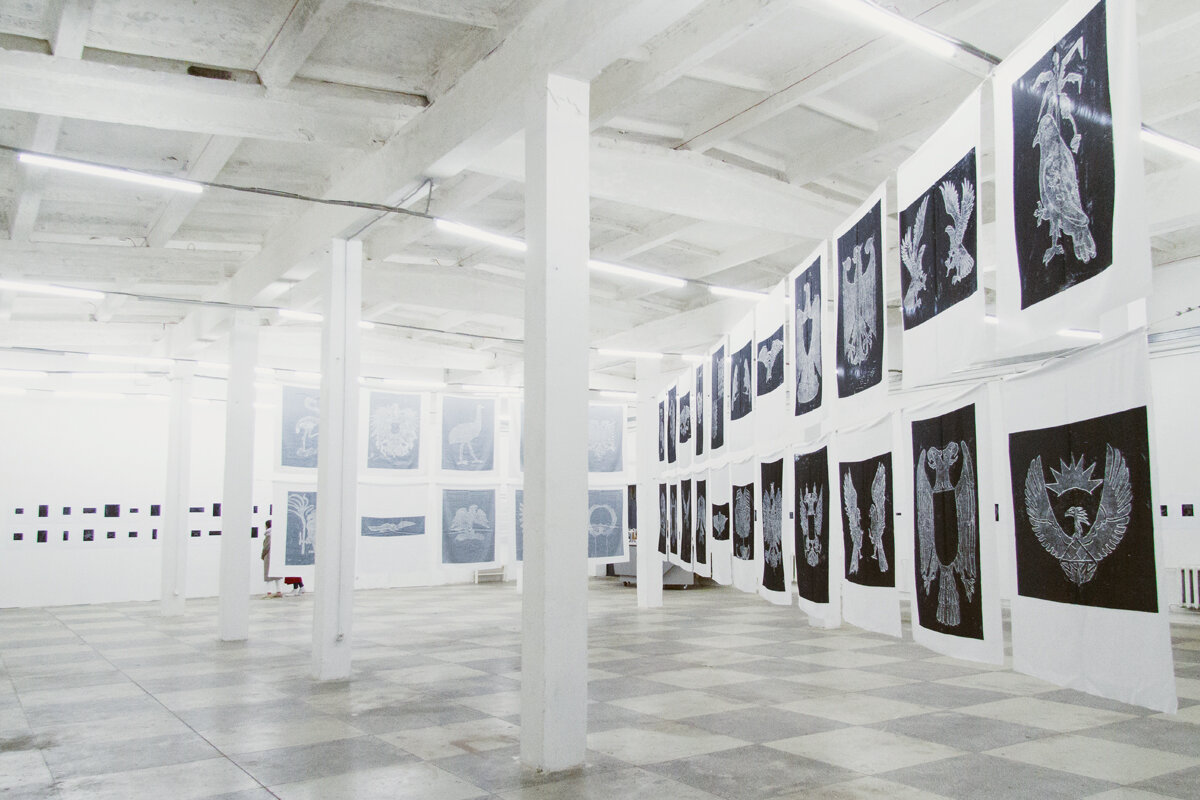

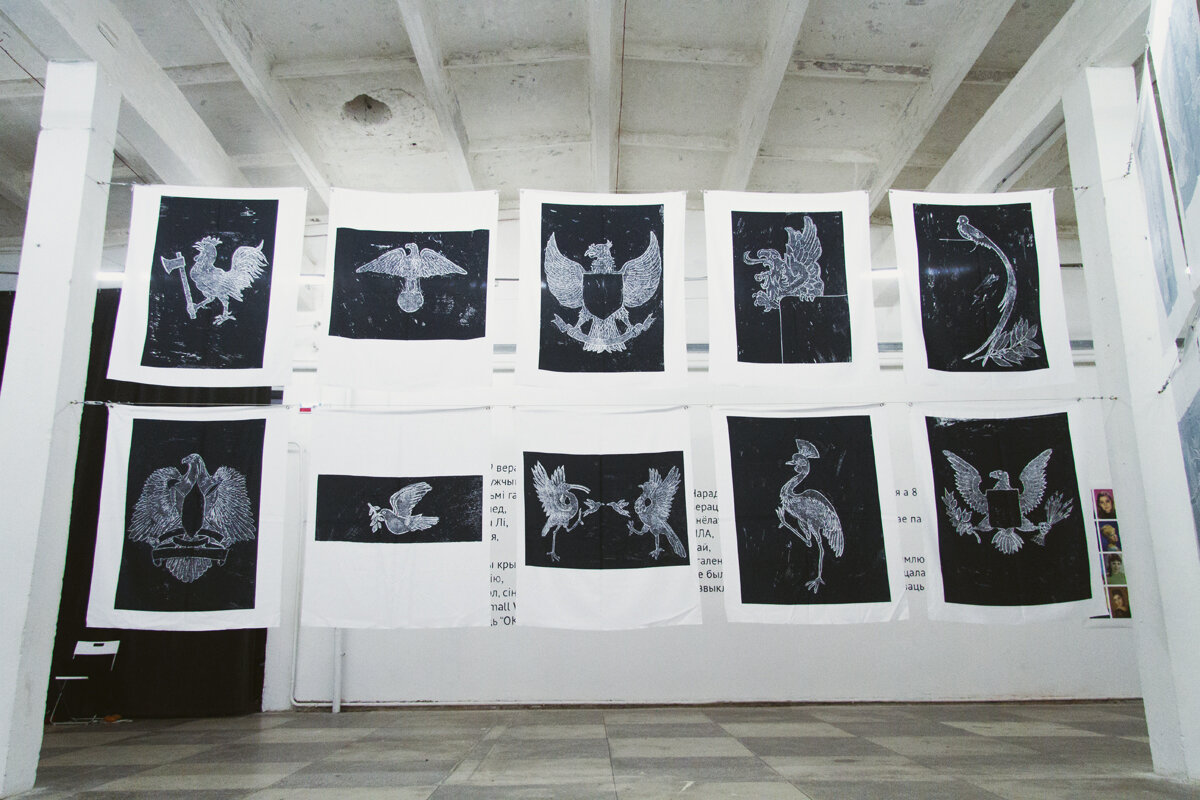

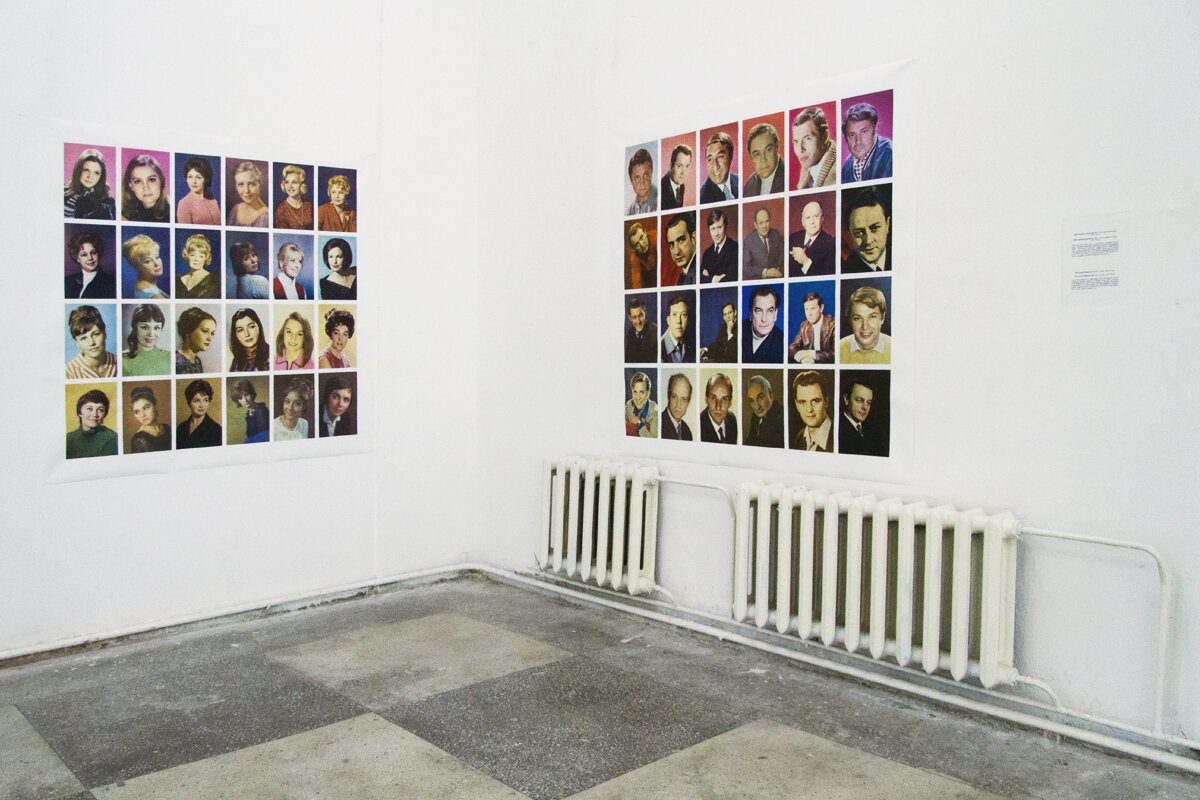
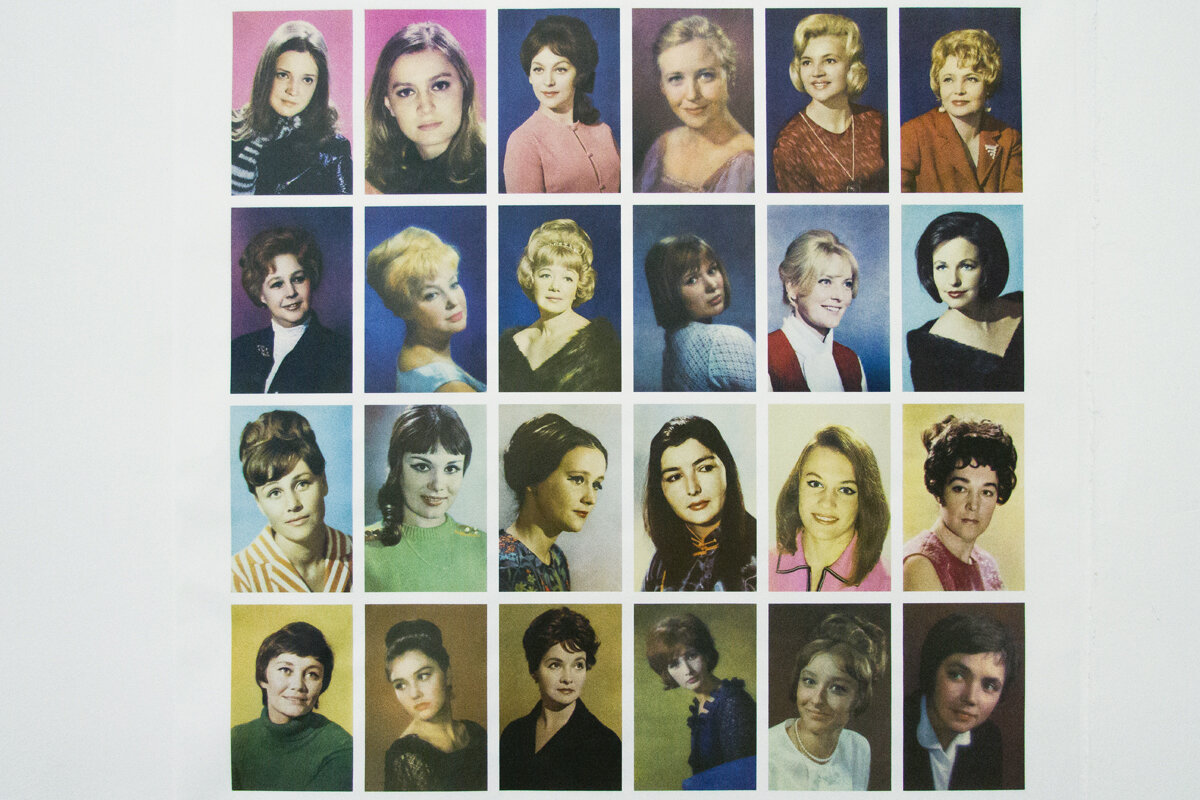

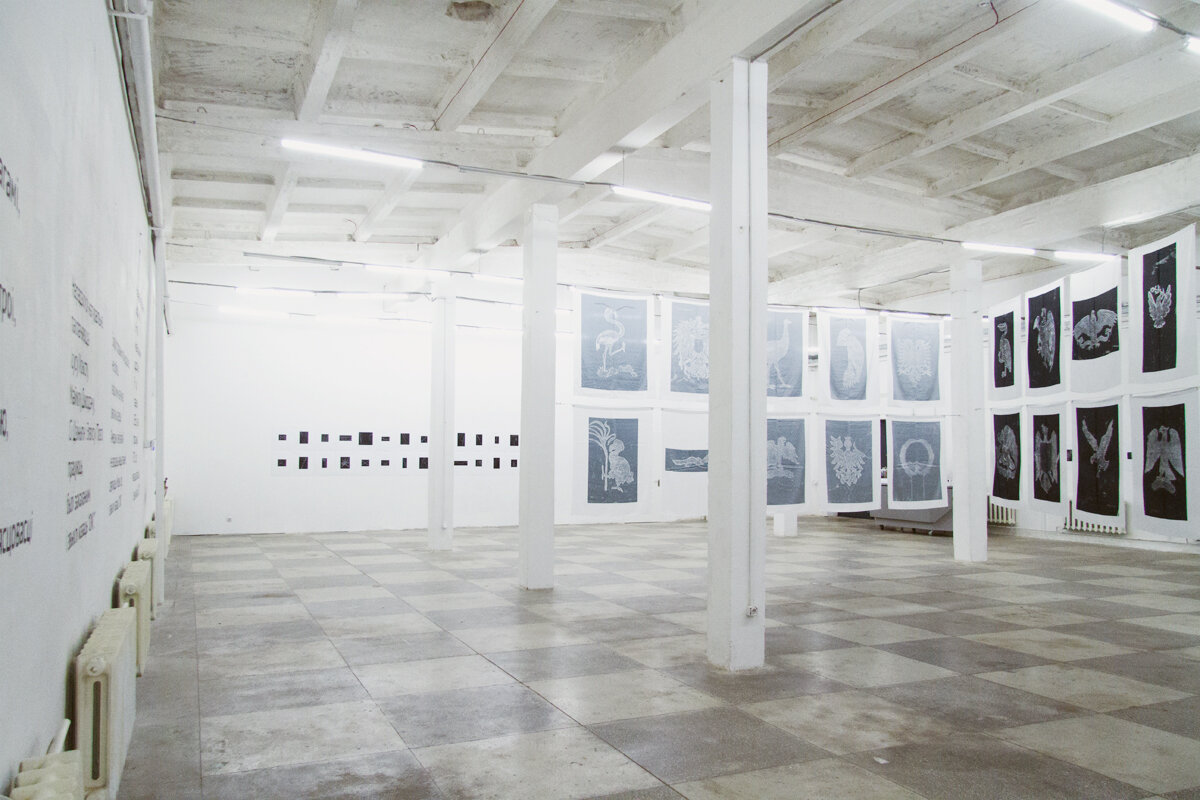



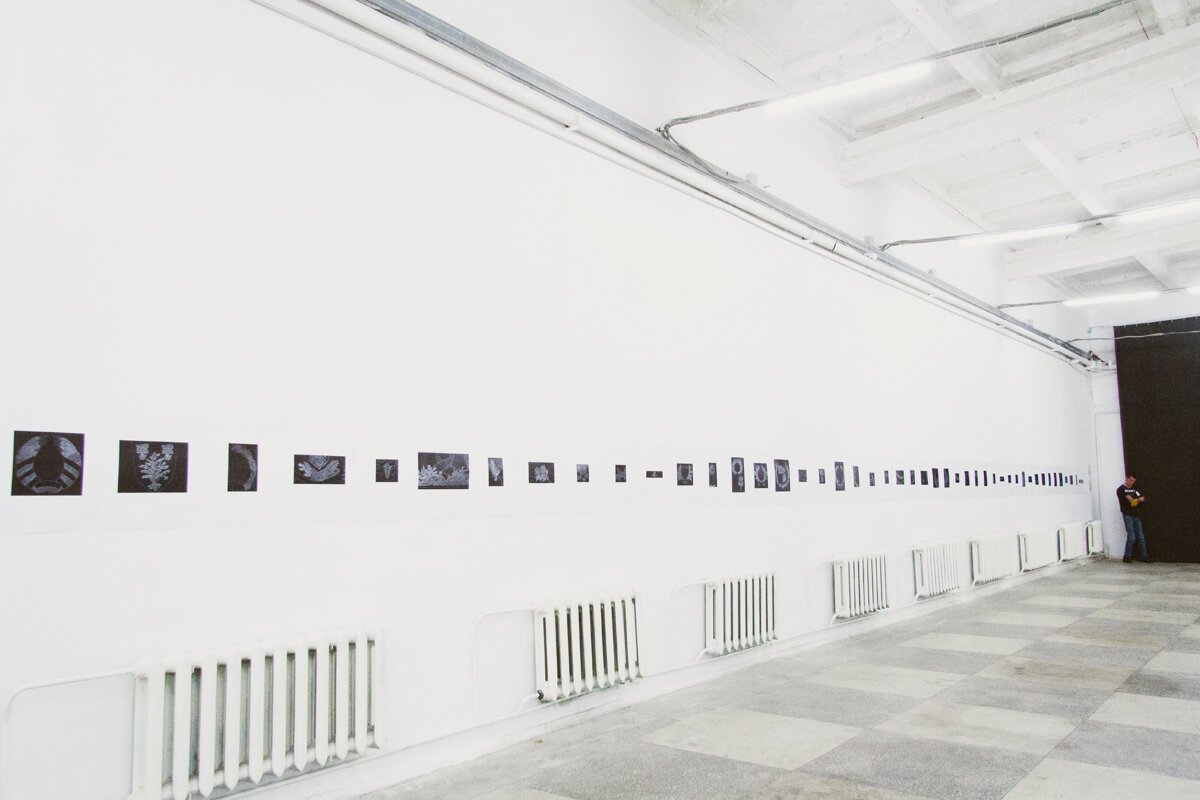
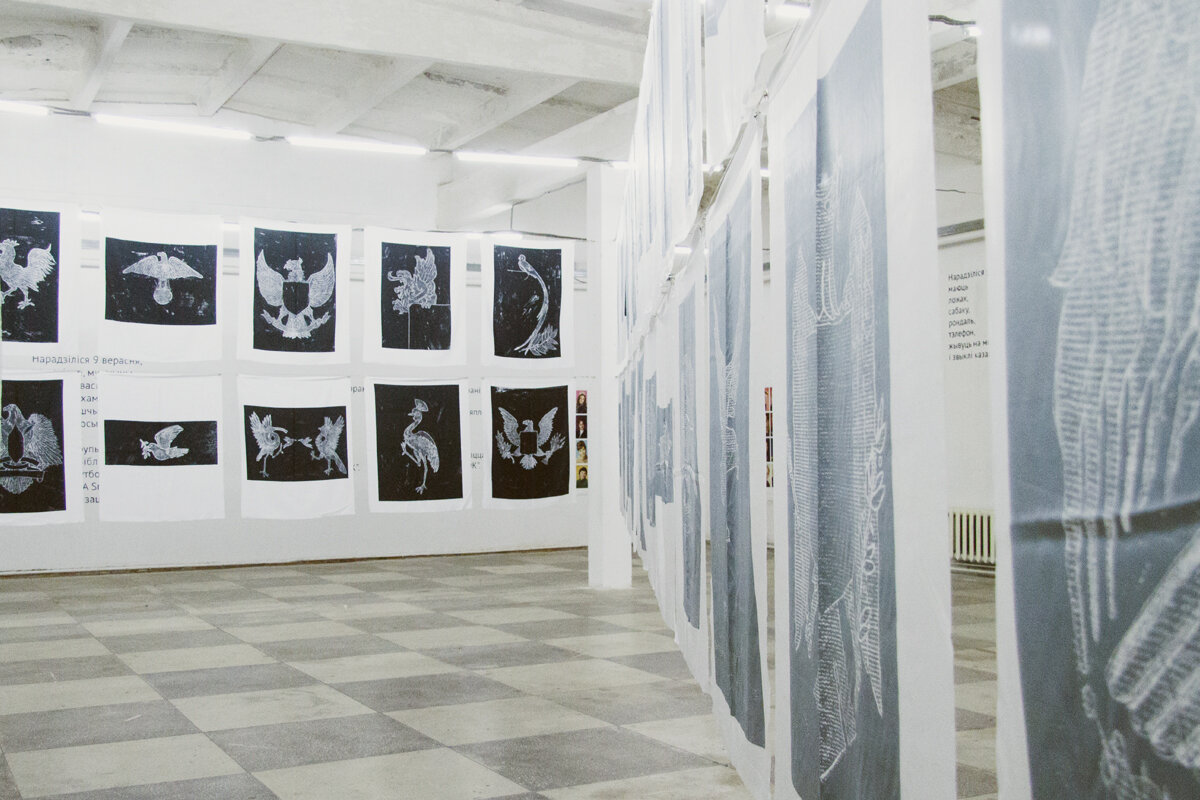
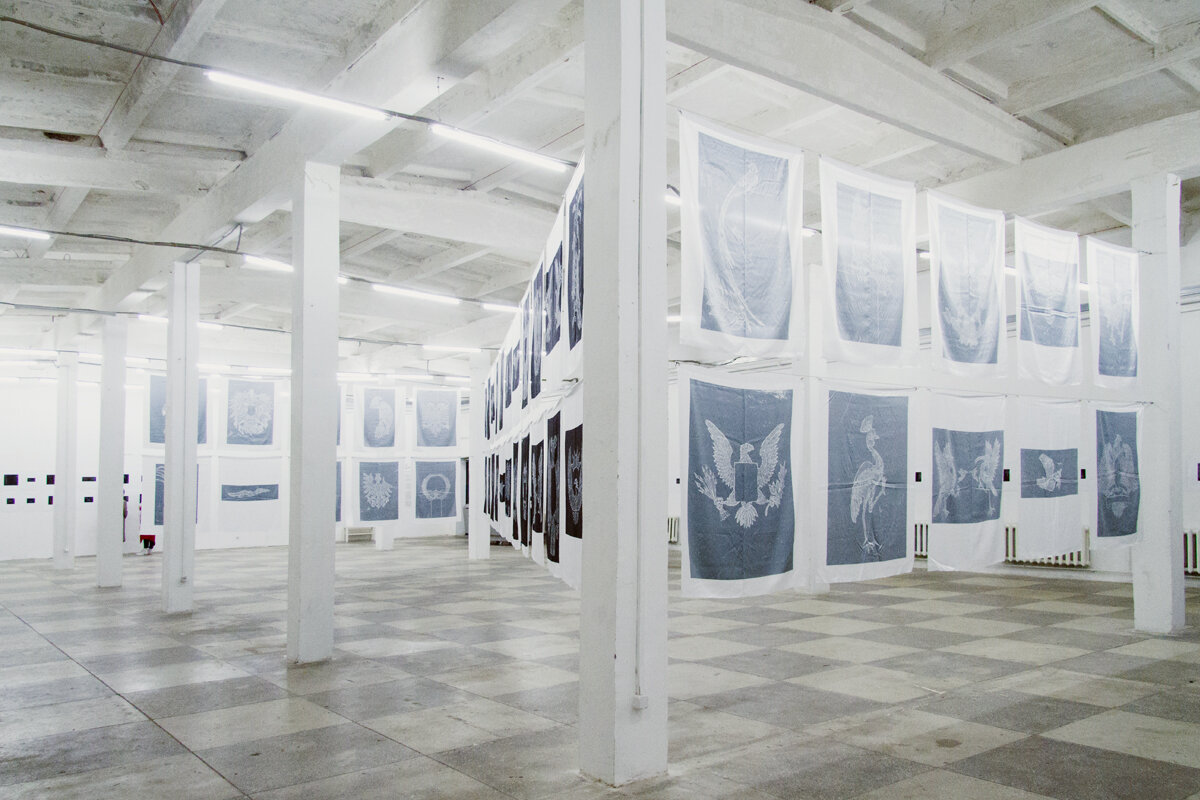


The “Ў” gallery of contemporary art is pleased to present a solo-exhibition by the Belarus-born artist, Alina Bliumis. The artist was born in Minsk, but she received her education in New York and has exhibited extensively in the US and in Europe. This is Bliumis’ first solo exhibition in her native Belarus.
The title of the exhibition refers to the artist’s 2018-2019 text-based series Most of Us Are. This 12 part work describes how “most of us” are born, believe, worship, don’t eat, consume, own, lose, dream, and spend our lives. Bliumis used statistics, demographic research and opinion poll data to define the main characteristics of a global citizen, and then construct a verbal portrait of “the most typical person.” Statistically, it is correct that “most of us are named Muhammad, last name Lee.” But as Stamatina Gregory noted in her text on Bliumis’s work (Political Animals, Aperto Raum, Berlin, 2018), “no citizen of the world cobbled together from shared demographic data truly exists.” And Bliumis’ statistic-based text portraits are anything but typical. Classifying, researching, collecting and creating new patterns of order is essential to the artist.
To create the series entitled Amateur Watching at Passport Control, the artist studied all 195 passports currently in circulation worldwide. She dissected the symbolism of the coats of arms featured on the covers, and identified four major categories: plants and trees, birds, big cats and weapons. From Lebanon’s cedar to Mauritius’ dodo, to Georgia’s lions and East Timor’s AK 47, the four works in the series, Amateur Bird Watching at Passport Control, Amateur Cat Watching at Passport Control, Amateur Flora Watching at Passport Control and Amateur Arsenal Watching at Passport Control (2016-2019), bring to life this curious intersection between nationalism and nature.
The exhibition also includes the works: My Soviet Childhood, He and My Soviet Childhood, She,2018. Bliumis created them together with her long time collaborator, Jeff Bliumis. The diptych comprises a collection of postcards of Soviet movie stars from the late 1960s through to the 1980s that he built up during his childhood. The artist says “the series is dedicated to all Soviet-era children who collected stamps, postcards, pins, cigarette and match boxes, soda bottles, candy wraps, juice box stickers” during that time. There is an implied association between identifying the symbols on modern passport covers and the curious eye that encouraged the collection of Soviet movie star postcards. Having past experience of this common childhood pleasure, of creating and curating collections of day-to-day objects, is essential in understanding both Most of Us Are and Amateur Watching at Passport Control series.
In My Soviet Childhood, He and She, the artists are trying to create a portrait of the most typical Soviet-era movie star. But there is a reverse process underway in Amateur Watching at Passport Control. Alina Bliumis is grasping the bigger picture of different coats of arms and dissecting them into their visual parts.
The exhibition is made possible by the generous support of the Trust for Mutual Understanding and the Franklin Furnace, NY
ALINA BLIUMIS, ON THE LAND OF EAGLES
Galerie Anne de Villepoix, Paris, France
September 14 - October 26, 2019











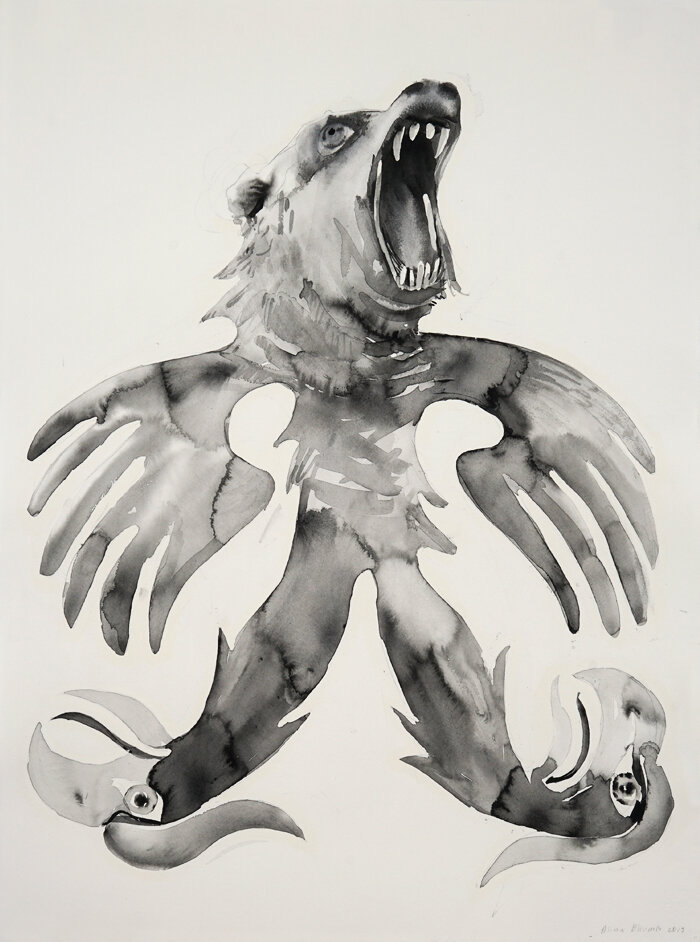








Alina Bliumis’ exhibition, On the Land of Eagles, voyages through global national symbols and identities. The Poems Without Borders series features the world’s tourism slogans in patterned rhymes. Amateur Bird Watching at Passport Control unlocks symbolic imagery from passport covers. The artist traces global territories in the allegorical Maps Unleashed drawings, and portrays national animal symbols in the Nature of Nations series.
“I feel Slovenia, I need Spain, Fiji Me, Cameroon is back.” Tourism slogans market countries to an expanding industry fueled by low-cost no-frills airlines. Abstract yet suggestive taglines allow foreigners to dream up their own ideas about the countries they want to visit. The series Poems Without Borders (2018-2019) arranges official national tourism slogans of forty-eight nations into sixteen poems. For this exhibition, the text-based piece is placed directly on the wall in one straight line that wraps around the gallery space.
Tourism and migration are the most significant manifestations of globalization. While economic, political and environmental migrants are routinely blocked at the border, tourists are ceaselessly wooed on various media and advertising platforms. While countries sculpt their national identities to make themselves more appealing to visitors, they use ethnic and cultural definitions to reinforce laws limiting migration.
“Free as a bird” we definitely are not. Yet ironically there are fifty bird symbols incorporated into the coats of arms depicted on the passport covers of forty-three nations. The Amateur Bird Watching at Passport Control series (2016-2017) presents forty-three works on paper. From eagles to doves, from Albania to Tonga, Bliumis studied all existing passport covers – 195 in total -- looking for birds in order to free them from their national context. She traced each bird, true to its source, with a focus on the species’ characteristics. The birds at the intersection of nation and nature include: the famous one-legged pose of a flamingo (Bahamas), a vulture in a gliding flight (Mali), an extinct flightless dodo (Mauritius), a rooster with an axe (Kenya) and a mythological creature that is part woman and part bird known as a Harpy (Liechtenstein).
Birds are not the only animals that nations use to symbolize themselves—a brown bear, a Fennec fox, an Apennine Wolf, a Barbary Macaque, a Marten or a goat are all official national animals. Nature of Nations (2019) is a series of watercolor portraits inspired by official national animals, heraldic design elements, geographical borders, folk fables, and stereotypes. The resulting images portray: A bird of prey, the bald eagle, freed from the USA coat of arms with a halo made of two olive branches is staring at the viewer, its claw is free of arrows. A seductive double-headed rooster of France is flirting with the audience. An outraged bear with wings is a combination of two symbols, the bear of the Soviet Union and the double-headed eagle of contemporary Russia. A goat of Iraq is crowned with a sword-shaped horn.
The series Nations Unleashed (2018-2019) is inspired by the historical tradition of satirical maps, which employ animal symbolism and stereotypes to convey biting political critique and/or to cover up human actions in certain political theaters. The series comprises watercolor and pencil drawings on paper. Delicately toned washes of blue surround loosely sketched landmasses populated by an array of diverse animals, each representing a critical political interest. Bliumis’ interpretations range from the literal – as in the American bald eagle – to the fanciful – as in a two-headed Scandinavian lion. What these maps lack in geographic accuracy is made up in thorough doses of imagination and humor, leaving further interpretation open to the viewer.
All four series in the exhibition investigate the formation of national identity, its historical and geographical roots and its ambitions in global geopolitics. National symbols often reflect national interests, but imagine for a moment if, as the myth goes, the U.S. Congress had conceded to Benjamin Franklin. For instance, he might have chosen the wild turkey as the national bird, instead of the bald eagle. Would the country’s domestic policies and international interests have unfolded differently?
ALINA BLIUMIS, AMATEUR BIRD WATCHING AT PASSPORT CONTROL and NATURE OF NATIONS at
Cosmopolitics, Comradeship, and the Commons, Suoja/Shelter festival, Helsinki, Finland
Curated by Corina L. Apostol, Ksenia Yurkova and Anastasia Vepreva
June 7-9, 2019





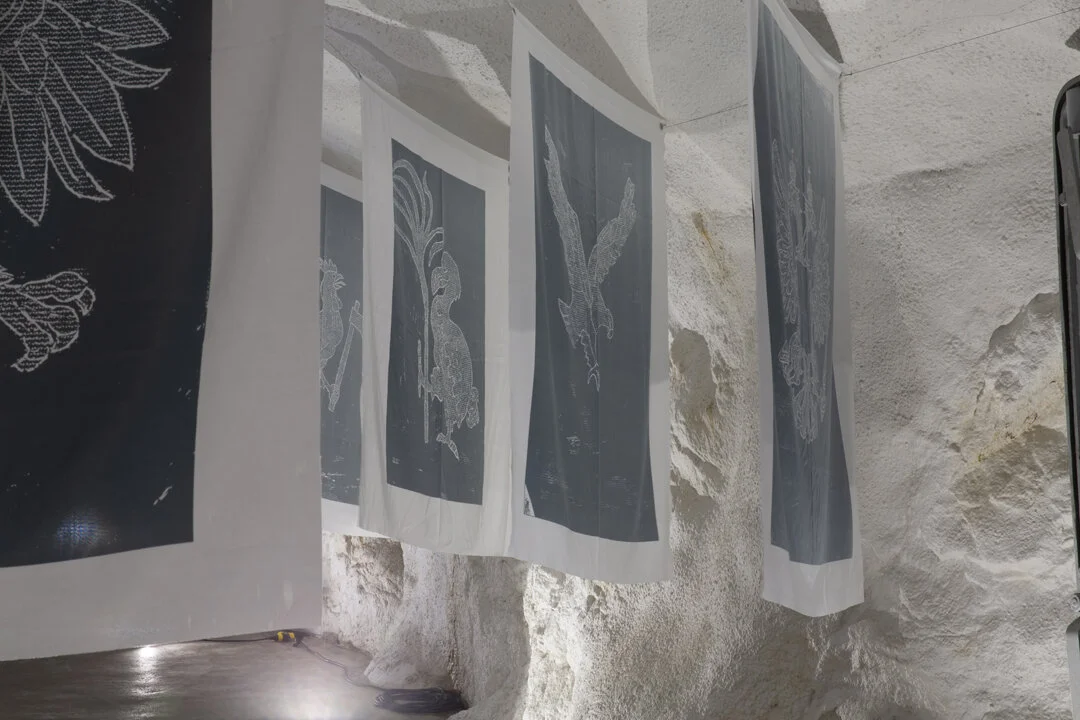


EXPLORING ENVIRONMENTAL PHILOSOPHY, ECOFEMINISM, QUEER ECOLOGY AND ECOLOGICAL RESILIENCE THROUGH KEY PROJECTS BY INTERNATIONAL ARTISTS, SOME ON VIEW FOR THE FIRST TIME IN FINLAND.
This year the festival will consider some of the most pressing issues of our times under the conceptual umbrella of eco-feminism, queer ecology, environmental philosophy, and ecological resilience. Entitled "Cosmopolitics, Comradeship, and the Commons" the 2019 festival-laboratory will feature diverse works including performance, installation art, poetry, film screenings, as well as discussions, artistic research, and an online publication bringing together artists and cultural practitioners from the Scandinavian countries, the Baltic Region, Eastern Europe, Russia, and beyond. Drawing on Isabelle Stengers' concept of "Cosmopolitics," where diverse stories, perspectives, and practices connect to lay the foundation for new strategies and radical possibilities, the Festival will act as a temporary commons for diverse approaches to the ecological crisis and its economic, social, and cultural affects and effects.
The festival invited artists, activists, educators, musicians, and all cultural producers in the greater Helsinki area and beyond to propose projects at the intersection of deep ecology, climate resilience, environmental philosophy, ecofeminism, and socially engaged practice.
Russian performative and experimental musical collective Techno-Poetry (Roman Osminkin, Anton Komandirov, Marina Shamova); Sweden-based art-collective HAMNEN (artist and filmmaker Klængur Gunnarsson; artist Maria Safronova Wahlström; artist Josef Mellergård; award-winning filmmaker, journalist and writer Johannes Wahlström); ex-academic turned video essayist Natalie Wynn based in the US; artist, activist and filmmaker Oto Hudec based in Slovakia; collaborating Romanian artists Anca Benera and Arnold Estefan; artist and filmmaker Oliver Ressler based in Austria; curator and art critic Raluca Voinea based in Romania; Sami artist, author and journalist Máret Ánne Sara based in Norway; Polish poetic choreographer, performance maker, curator of experiences Valentine Tanz/ Vala Tomasz Foltyn based in Denmark; UK-based art historians and curators Maja and Reuben Fowkes; and Belarusian-American artist Alina Bliumis are amongst this year's participants.
More than 20 participating artists, musicians, curators and theoreticians were selected via an international open call: Anna Sopova and Antanas Jatsinevichys (Russia); Inês Tartaruga Água (Portugal); Ipek Burçak (Turkey); Collective HEXY (Justyna Jakóbowska, Roksana Kularska-Król, Justyna Stopnicka) (Poland); Lea Roth (Germany); Laurene Bois-Mariage (Finland); Maria Veits (Russia/ Israel); Andréa Stanislav (US); Axel Straschnoy (Finland); Vo Ezn (Georgia); Mathilda Franzén (Sweden); Natalia Skobeeva (Russia/ Belgium); Rabota (Marika Krasina & Anton Kryvulia) (Germany/ Belarus); Roman Golovko (Russia); Silvia Amancei and Bogdan Armanu (Romania); Susi Disorder (United Kingdom); Saša Nemec (Slovenia/ Finland); Taisia Korotkova (Russia); Valerii Shevchenko (Russia); Vera Kavaleuskaya (Finland/ Belarus); Verneri Salonen (Finland); zh v yu (Natasha Zhukova, Katya Volkova, Dasha Yurychuk) (Russia).
The festival also presents the Suoja/Shelter Reader, a compilation of educational materials in conversation with the performances, art installations, films, music, and discussions taking place throughout the festival. The Reader has been put together by the festival curator and organizers. The reader also contains a themed glossary of terms.
Suoja/ Shelter is held at the Space for Free Arts under the Auspices of the University of the Arts Helsinki (UNIARTS). It is supported by the City of Helsinki, the Finnish Cultural Foundation (SKR), and the Arts Promotion Center Finland ( TAIKE). Spanning three full days of programming between June 7-9 at the public shelter turned into the Space For Free Arts/ Vapaan Taiteen Tila in the Sörnäinen neighbourhood of Finland's capital, the festival is free and open to the public. It is curated by Corina L. Apostol, an independent curator and writer based in New York/US and Constanța/Romania, together with artist and curator Ksenia Yurkova (Finland/ Russia) and artist and curator Anastasia Vepreva (Russia).
ALINA AND JEFF BLIUMIS, WHICH COUNTRY IS THE BEST TO MOVE TO?
part of
PERSONA GRATA, A collaborative project between the Musée national de l’histoire de l’immigration
and the MAC VAL– Musée d’art contemporain du Val-de-Marne
Curators Anne-Laure Flacelière and Isabelle Renard
16 October 2018 - 20 January 2019








Musée national de l’histoire de l’immigration
16 October 2018 – 20 January 2019
Co-curated by Anne-Laure Flacelière, MAC VAL collection Study and Development Officer and Isabelle Renard, Collections and Exhibitions Director at the Musée national de l’histoire de l’immigration
With works by Bertille Bak, Dominique Blais, Alina Bliumis, Jeff Bliumis, Halida Boughriet, Kyungwoo Chun, Philippe Cognée, Pascale Consigny, Hamid Debarrah, Latifa Echakhch, Eléonore False, Claire Fontaine, Laura Henno, Pierre Huyghe, Bertrand Lamarche, Xie Lei, Lahouari Mohammed Bakir, Moataz Nasr, Eva Nielsen, Gina Pane, Laure Prouvost, Enrique Ramirez, Judit Reigl, Anri Sala, Sarkis, Zineb Sedira, Bruno Serralongue, Chiharu Shiota, Société Réaliste, Dan Stockholm, Barthélémy Toguo...
Welcome ! Festival
6 October – 11 November 2018
Programming: Stéphane Malfettes
Under the eyes of philosophers Fabienne Brugère and Guillaume Le Blanc, authors of La fin de l’hospitalité, this two-fold exhibition will be complemented by a cultural programming: Welcome! at the Musée national de l’histoire de l’immigration (6 October-11 November 2018) and Attention fragile at the MAC VAL (30 November, 1 and 2 December 2018).
MAC VAL – Musée d’art contemporain du Val-de-Marne
16 October 2018 – 24February 2019
Curated by Ingrid Jurzak, MAC VAL Collection Study and Management Officer
With works by Eduardo Arroyo, Marcos Avila Forero, Bertille Bak, Richard Baquié, Taysir Batniji, Ben, Bruno Boudjelal, Mark Brusse, Pierre Buraglio, Mircea Cantor, Étienne Chambaud, Kyungwoo Chun, Philippe Cognée, Delphine Coindet, Julien Discrit, Thierry Fontaine, Jochen Gerz, Ghazel, Marie-Ange Guilleminot, Mona Hatoum, Éric Hattan, Laura Henno, Emily Jacir, Yeondoo Jung, Bouchra Khalili, Kimsooja, Claude Lévêque, Lahouari Mohammed Bakir, Lucy Orta, Bernard Pagès, Yan Pei-Ming, Cécile Paris, Mathieu Pernot, Jacqueline Salmon, Bruno Serralongue, Esther Shalev-Gerz, Société Réaliste, Djamel Tatah, Barthélémy Toguo, Patrick Tosani, Sabine Weiss...
Attention fragile
Festival-Rencontre, 30 November, 1 and 2 December 2018
Programming: Stéphanie Airaud - Thibault Capéran
The Musée national de l’histoire de l’immigration and the MAC VAL- Musée d’art contemporain du Val-de-Marne are collaborating to present a project questioning the notion of hospitality through the prism of contemporary creation. Together, the two institutions- a social museum that value contemporary creation and a contemporary art museum that tackles social issues- are happy to present “Persona grata”, an exhibition organized over the two locations with a rich cultural programming: an occasion for artists to explore all the dimensions of what constitutes or corrodes the notions of hospitality and alterity through their own vision and sensitivity.
The acceleration of migratory flows and the growing place these issues occupy in the public debate increasingly question the foundations of our societies. On one hand, camps and walls mushroom and confirm the irreversible setback of our hospitality duty, while on the other, citizen involvement grows to help, support and welcome migrants. Is the answer of today’s harsh society to bring emergency assistance rather than implement long-term and effective hospitality policies?
In this context and from the collections of both museums, this artistic partnership aims at highlighting a contemporary creation that reflects today’s world as well as tackling these issues from the point of view of the many artists who have explored the theme of hospitality over the last years.
The exhibition will provide a platform for artists to share their analyses, critics and feelings toward national fold, behaviors of rejection and revolt. These artistic testimonies will help us think these questions through and look at ourselves yet without any moralistic judgment.
Through this unique and engaged partnership project, the Musée national de l’histoire de l’immigration and the MAC VAL look to raise awareness, foster reflection and debate, and call our certitudes into question. Although central, the issues related to migratory flows do not cross out other neglected –and little known- forms of hospitality toward helpless and weakened populations. The exhibition will bring forth proposals around community life, care for others, the necessity of nursing homes, public health-care and hospitality centers held in a spirit of attentiveness, kindness and sharing we should rehabilitate.
ALINA BLIUMIS, POLITICAL ANIMALS
Aperto Raum, Berlin
13 September - 22 October 2018

















Aperto Raum is proud to present Political Animals by Alina Bliumis, her first solo exhibition In Germany. The title of the exhibition references Aristotle's term in his Politics. "However, instead of meaning, as Aristotle did, that we build society by practicing good social relations in organized establishments called cities (polis), Bliumis mockingly takes this expression at face value through a comic, yet productive form of literal mistranslation by focusing the use of birds, bears, and so forth, in political theater. Regardless of biology, states divide the world into two types of fictive persons: their citizenry, and everyone else. So as to keep this exclusionary set-up under control we had to invite something bestial, but sadly, something all too human: the police. Although borders are themselves fictive, try to cross one without your identity papers. But really, what is identity anyways? I mean if your documents are expired, does your name do so well? Or perhaps, your height and eye color vanish in a puff of smoke, poof!” - excerpt from Adam Kleinman, "Plucked," exhibition catalogue
Political Animals presents four series: Amateur Bird Watching at Passport Control, If There Is A Bear, Political Animals and Most Of Us Are. Amateur Bird Watching at Passport Control focuses on the birds that are featured on passport covers from countries around the world. From eagles to doves, from Albania to Tonga, this series explores the intersection of nation and nature. The series If There Is A Bear is inspired by the TV ad titled The Bear, created by Hal Riney for the 1984 U.S. presidential campaign of Republican candidate Ronald Reagan. This example of the Cold War narrative make us aware that using animal imagery for the purpose of politics is not merely an aesthetic choice, but in fact a political strategy. While Political Animals is blurring the boundaries between the human and the animal, Most of Us Are is a study of the human species based on statistics of the “most typical” person worldwide.
Alina Bliumis, born in Minsk, Belarus, is a New York-based artist. She has exhibited internationally at the First, Second, and Third Moscow Biennales of Contemporary Art (Moscow, Russia), Busan Biennale 2006 (Busan, South Korea), Assab One (Milan, Italy), the Bronx Museum of the Arts (New York, US), Galerie Anne de Villepoix (Paris, France), Centre d’art Contemporain (Meymac, France), The James Gallery, The Graduate Center CUNY (New York, US), Museum of Contemporary Art (Cleveland, US), Museums of Bat Yam (Bat-Yam, Israel), the Jewish Museum (New York, US), the Saatchi Gallery (London, UK) and the Victoria and Albert Museum (London, UK). Her works are in various private and public collections, including the Moscow Museum of Modern Art (Russia), Museums of Bat Yam (Israel), the Saatchi Collection (UK), the Harvard Business School (US), the Museum of Immigration History, Paris (France) and the Victoria and Albert Museum, London (UK).
ALINA AND JEFF BLIUMIS CULTURAL TIPS FOR NEW AMERICANS
SPRING/BREAK Art Show, NY, USA, 2018
curator Ksenia M. Soboleva


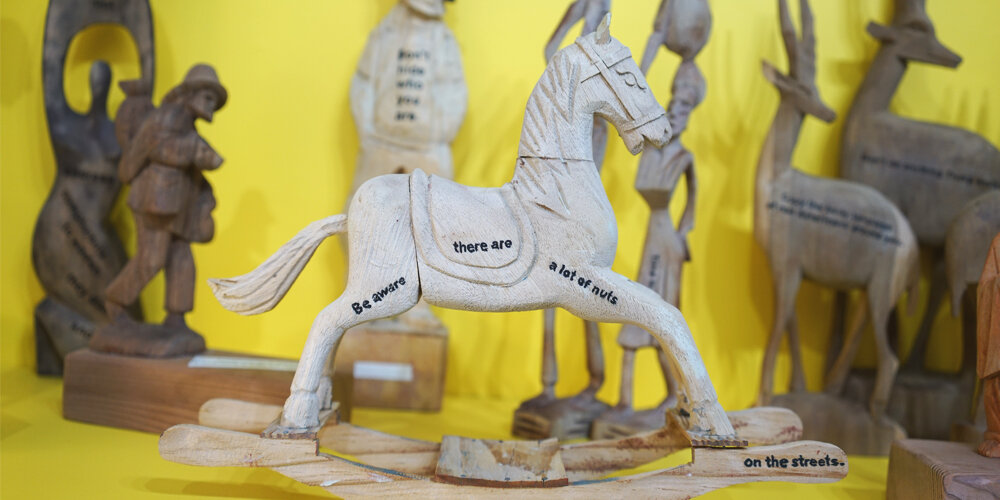

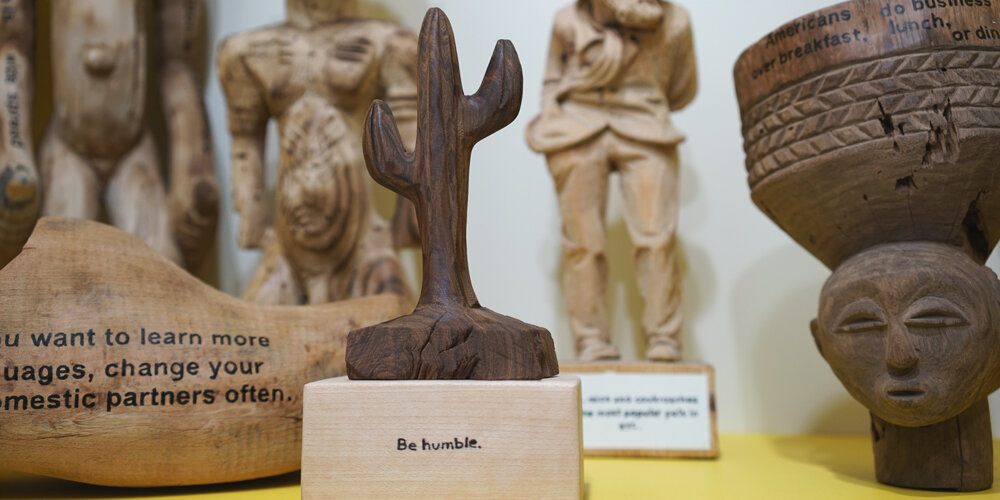















Throughout their practice, Alina and Jeff Bliumis engage in an ongoing investigation into foreignness and the ontology of cultural misfits. As exemplified by the title of their first catalogue, Receiving the Stranger, the artists’ work is rooted in the desire to communicate through difference. Using communication as the medium par excellence, their projects raise questions around what constitutes community, what constitutes borders, and how the former are shaped by the latter. Most importantly, the artists acknowledge that language itself can function as a border, as a paradigm of power, and can be used to frame communities. In the words of literary theorist Leo Bersani, language doesn’t merely describe identity but actually produces it.
Cultural Tips for New Americans Under Trump reiterates a project that Alina & Jeff Bliumis first undertook in 2011. In this earlier iteration, Cultural Tips for New Americans, the artists set out to compile advice that people who consider themselves “real Americans” give to newcomers, to supposedly help them assimilate to their new surroundings. Characterized by a certain lightheartedness and humor, these cultural tips in fact reveal inherent aspects of American society and say more about Americans themselves than the communities to whom they address their advice.
Having immigrated to the United States from Eastern Europe, Alina and Jeff Bliumis picked up on this American encouragement to “blend in” early on. Now, in the wake of our current political climate, the artists felt an urgency to revisit this project, and gathered additional cultural tips for new Americans living under the Trump presidency using handbooks, public forums, street question- naires, and social media. The collection of tips that resulted from the artists’ inquiry ranges from amusing suggestions (If someone says ‘come over anytime’ don’t take it literally) to harsh realities (Sometimes undocumented immigrants stay undocumented for a long time). Concurrently, the artists collected ethnic wooden souvenirs, which radiate a certain fetishization of otherness, from all around New York City and sandblasted these objects to remove their original decorations and uncover the wood underneath. The cultural tips are then written onto the wooden souvenirs in ink, causing them to become decontextualized objects, much like the immigrants to whom the cultural tips are addressed.
by Ksenia M. Soboleva,
Cultural Tips for New Americans Under Trump, 2018, Series of 72 objects, Wood and ink, Dimensions variable, Unique.
ALINA AND JEFF BLIUMIS A PAINTING FOR A FAMILY DINNER at SPECTERS OF COMMUNISM: CONTEMPORARY RUSSIAN ART
James Gallery, CUNY Graduate Center, NY, USA, 2015
curator Boris Groys
Boris Groys
Excerpt from Specters of Communism: Contemporary Russian Art, The James Gallery and e-flux, New York
"Jeff and Alina Bliumis, a pair of New York-based, Russian-speaking artists born in Moldova and Belarus, respectively, also open themselves up to the potentialities of new landscapes in the work that produced an installation of thirty-nine 24 x 24 inch photographs at The James Gallery. For their long-term project A Painting for a Family Dinner (2008-2013), the Bliumis' traveled the world from The Bronx to China stopping in Italy and Israel, looking for hosts who would exchange a home-cooked meal for a small sweetly but primitively rendered painting. Their project, which is the only one in the exhibition that does not directly engage with Russia, is documented through photographs where they stand with their temporarily adoptive families and in a set of limited-edition books that trace the project's steps within each country. Reviving the barter system in the twenty-first century when our transactions have advanced to new currencies, like Bitcoins and devices like Apple Pay, the Bliumis' humble proposition is inspiring, even though its success is not guaranteed in the capitalist system. A Painting for a Family Dinner allows us to see a positive side of communism because it puts into practice the notion of equal and shared property circulating within an international codependent community".
ALINA AND JEFF BLIUMIS CULTURAL TIPS FOR NEW AMERICANS
Public Art Project, New York, 2009-2011
Cultural Tips takeaway, Toomer Labzda Gallery, New York 2012







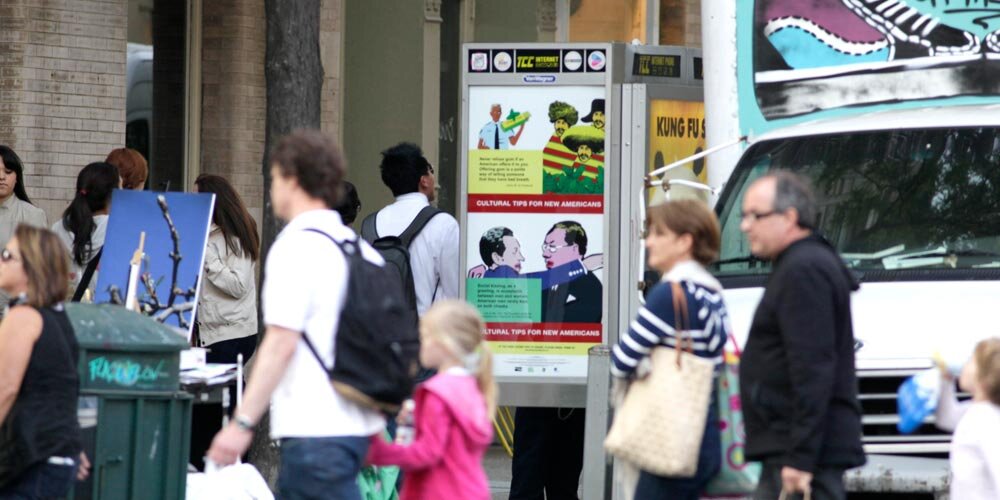








To be a foreigner — one who is defined as not from here — often means unknowingly breaking rigid social and cultural rules. Definitions of these social and cultural standards often say a lot about the native society. As the proverbial Land of Opportunity, the United States has always had a steady stream of new Americans and "what it means to be an American" is loudly and frequently discussed on national television.
For Cultural Tips For New Americans (2009-2011, Public Art Project, New York), we gathered advice to help recent arrivals assimilate and understand their new home. We took advice from published guides, public forums, streets questionnaires, social websites, and friends to create tips like:
"When two Americans are standing and talking to each other they stay at least 16 inches away from each other." Life in the USA, The Complete Guide for Immigrants and Americans by Elliot Essman
and
"Never refuse gum if an American offers it to use. Offering gum is a polite way to tell someone that they have bad breath." Jenny W. on Facebook
We have illustrated these tips and produced handbook, phone kiosk posters, stickers and sculptural series.
We installed the posters onto phone kiosks and placed stickers in various places on the Bowery and in Chinatown and Soho, from May 1 to May 28, 2011.
Accompanying the street-level posters, we engaged with the lower east side community and gathered one hundred and four new cultural tips from visitors, in exchange for the handbook on Saturday May 7, 2011 at NoLongerEmpty booth / Rivington and Chrystie Streets New York, during the Festival of Ideas for the New City organized by the New Museum.
*The project has been made possible by the Franklin Furnace Fund, Blue Print Fellowship, NoLongerEmpty and The Festival of Ideas for the New City, organized by the New Museum.
Cultural Tips takeaway (2011-2013, Series of 104 objects, Wood and ink, Dimensions variable, Unique) at Toomer Labzda Gallery (located only few blocks away from where the Festival took place) was a continuation of the Cultural Tips For New Americans project. Inhabiting the gallery as a procession of objects, a gift shop of sorts; each tip claims an international souvenir stripped of color and ethnic identity, such as:
"American action movies are multi-billion dollar export industry, but don't reflect real life. Americans only occasionally drive over 100 mph, shoot each other and blow things up." Dave
"Speak loudly and chant U-S-A, U-S-A wherever feeling uber patriotic." D.H.
"When an American asks you 'what's up?' your standard response should be 'nothing much.'" Elena G.
"Smile even if you are sad." Heldon
"'Hope to see you again' does not mean that an American hopes to see you again." Emily
"If you hang out with an American for an hour you should hug them goodbye."Rebecca
"Americans don't look each other in the eyes when they cheer glasses." Stephanie
"The hard sell only works in movies and for Donald Trump." A.B.
"We really don't know anything about where you are from but please tell we are interested." Dimitry
"In capitalist America bank robs you!" Greg
There were one hundred and four wood objects, for one hundred and four tips, for one hundred and four dollars each - with the aim that each tip would be acquired and taken from the gallery before the exhibition closes. Thus bringing the project full circle and presenting the cultural tips back to the local lower east side community from which they derived.




